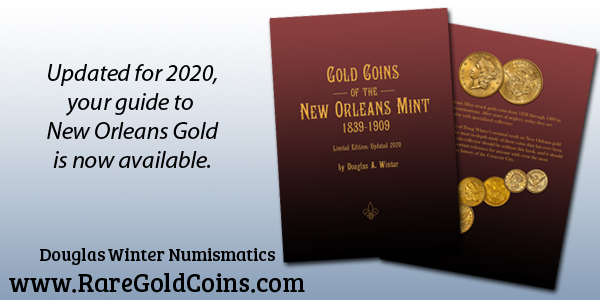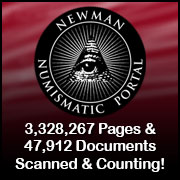
Visit our NBS Sponsors


About UsThe Numismatic Bibliomania Society is a non-profit association devoted to the study and enjoyment of numismatic literature. For more information please see our web site at coinbooks.org SubscriptionsThose wishing to become new E-Sylum subscribers (or wishing to Unsubscribe) can go to the following web page link MembershipThere is a membership application available on the web site Membership Application To join, print the application and return it with your check to the address printed on the application. Print/Digital membership is $40 to addresses in the U.S., and $60 elsewhere. A digital-only membership is available for $25. For those without web access, write to: Charles Heck, Treasurer AsylumFor Asylum mailing address changes and other membership questions, contact Chuck at this email address: treasurer@coinbooks.org SubmissionsTo submit items for publication in The E-Sylum, write to the Editor at this address: whomren@gmail.com BUY THE BOOK BEFORE THE COINSale Calendar
|
- WAYNE'S WORDS: THE E-SYLUM JULY 4, 2021
- NBS EVENTS AT 2021 ANA WORLD'S FAIR OF MONEY
- SCOTT RUBIN LIBRARY PART TWO HIGHLIGHTS
- NEW BOOK: SIEGE COINS OF THE WORLD 1453-1902
- NEW BOOK: BANKNOTE YEARBOOK 11TH EDITION
- AINA FORUM: ANTIOCH AND JERUSALEM
- PONDERING PANDEMIC PUBLISHING
- NUMISMATIC NOTABLES: KEN BRESSETT
- COINS THAT AREN'T WHAT THEY APPEAR TO BE
- VIDEO: JUDITH KAGIN INTERVIEW
- IAN RANK-BROADLEY STATUE OF PRINCESS DIANA
- NOTES FROM E-SYLUM READERS: JULY 4, 2021
- THE ROBERT S. CHAMBERLAIN COLLECTIONS
- AN ACT OF INDEPENDENCE: THE FIRST U.S. COIN
- REVOLUTIONARY THEMED NUMISMATICS
- BORN ON THE FOURTH OF JULY
- VOCABULARY TERM: ENGRAVING MASTER
- WILLIAM ELLIOT WOODWARD (1825-1892)
- MORE ON THE LAWRENCE BROTHERS
- HARVEY STACK'S NUMISMATIC FAMILY, PART 99
- THE IRV RATCLIFFE MORMON AND UTAH COLLECTION
- NGC PARENT CERTIFIED COLLECTIBLES GROUP SOLD
- NUMISMATIC NUGGETS: JULY 4, 2021
- ROMAN COIN FIND: SAFE CROSSING OFFERINGS
- OLD WELL BENEATH HOME YIELDS OLD COIN
- THE HORROR OF DRUM-POLISHED EIGHT REALES
- U.S. COAST GUARD SILVER MEDAL
- THE LIBERTY DOLLAR IS BACK
- THE MYSTERIOUS NEWPORT TOWER
- THE ART OF STACKING COINS
Click here to read the thin version on the web
Click here to subscribe
Click here to access the complete archive
To comment or submit articles, reply to whomren@gmail.com
Content presented in The E-Sylum is not necessarily researched or independently fact-checked, and views expressed do not necessarily represent those of the Numismatic Bibliomania Society.
WAYNE'S WORDS: THE E-SYLUM JULY 4, 2021
 New subscribers this week include:
Mark Vitunic, courtesy Craig McDonald;
and Kenneth Rasure, who saw us mentioned in the book
New subscribers this week include:
Mark Vitunic, courtesy Craig McDonald;
and Kenneth Rasure, who saw us mentioned in the book The Expert’s Guide to Collecting & Investing In Rare Coins
by Q. David Bowers.
Welcome aboard! We now have 6,686 subscribers.
Thank you for reading The E-Sylum. If you enjoy it, please send me the email addresses of friends you think may enjoy it as well and I'll send them a subscription. Contact me at whomren@gmail.com anytime regarding your subscription, or questions, comments or suggestions about our content.
This week we open with NBS events at the ANA convention, numismatic literature sale highlights, two new books, updates from the Newman Numismatic Portal, and more.
Other topics this week include pandemic publishing, coin designer Ian Rank-Broadley, the Robert S. Chamberlain collections, the first U.S. coin, W. E. Woodward, Irv Ratcliffe, Numismatic Nuggets, safe crossing offerings, the U.S. Coast Guard silver medal, and the return of the Liberty Dollar.
To learn more about the Carson City Mint, the scarce first printing of The Fantastic 1804 Dollar, siege coins, the career of Ken Bressett, Yankee Doodle Dandy numismatists, the Jimmy Hayes sales, the sale of Certified Collectibles Group, drum-polished shipwreck coins, and the mysterious Newport Tower, read on. Have a great week, everyone!
Wayne Homren
Editor, The E-Sylum

NBS EVENTS AT 2021 ANA WORLD'S FAIR OF MONEY
NBS President Tom Harrison submitted this note on events at the upcoming ANA convention. Mark your calendars! -Editor
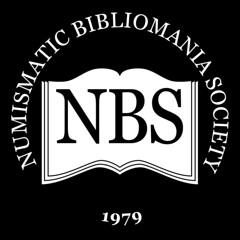 We are excited to once again be attending the ANA World's Fair of Money in person. The Numismatic Bibliomania Society will be hosting club table #724 from Tuesday - Friday. We will be displaying some of the highlights from our all important charity auction that will be held during the General Meeting on Friday. We will also be offering NBS coffee mugs for a $25 donation to the NBS. Please stop by to say hi and share your thoughts about the NBS.
We are excited to once again be attending the ANA World's Fair of Money in person. The Numismatic Bibliomania Society will be hosting club table #724 from Tuesday - Friday. We will be displaying some of the highlights from our all important charity auction that will be held during the General Meeting on Friday. We will also be offering NBS coffee mugs for a $25 donation to the NBS. Please stop by to say hi and share your thoughts about the NBS.
The NBS will be holding our Symposium on Thursday the 12th at 1:00 PM in room 24. The Symposium will feature a presentation by Rusty Goe who is a recognized authority on the history of the Carson City Mint and its coinage. He will be speaking about his three volume set titled The Confident Carson City Coin Collector. The General Meeting will be held on Friday the 13th at 11:30 AM in room 7. The meeting will include the announcement of the awards for the best articles in our print journal, The Asylum and a presentation by NBS Vice President, Len Augsburger discussing the digitalization of Coin World and Numismatic News. Another highlight will be the charity auction that always provides a fascinating variety of literature. The auction is our one annual fund-raiser, so we hope you will join us to help support the mission of the NBS. Looking forward to gathering in Rosemont.
And here's another nice piece of NBS business at the convention. -Editor
Olivia Crawford, Assistant Editor of The Numismatist writes:
"It is with great pleasure that I inform you that your publication The E-Sylum has been selected by a panel of judges to receive first place in the "Electronic" category of the 2021 Barbara J. Gregory Outstanding Club Publications competition. Congratulations!
"The ANA Literary Awards will be presented at the World’s Fair of Money® in Rosemont during the Member & Awards Celebration on Thursday, August 12, at 3 p.m. in Room 25 of the Donald E. Stephens Convention Center. Winners also will be featured in the September 2021 issue of The Numismatist."
This is a great honor - the competition gets tougher every year as more and more clubs up their online game. Thank you! If you have friends who might enjoy The E-Sylum, just send me their email addresses or direct them to http://e-sylum.org/ . -Editor
For more information about NBS, see:
https://www.coinbooks.org

SCOTT RUBIN LIBRARY PART TWO HIGHLIGHTS
Here are some additional highlights from the Kolbe & Fanning sale of Part Two of the P. Scott Rubin Library. -Editor
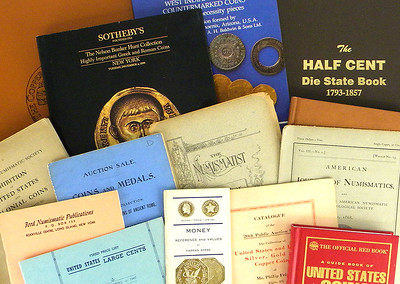
Kolbe & Fanning Numismatic Booksellers are conducting our mail-bid sale of Part Two of the P. Scott Rubin Library, which closes on Saturday, July 10, 2021. The 923-lot sale features material from the extraordinary library formed over the course of more than fifty years by Scott Rubin, of which highlights were sold in our Sale 157 last year. The auction is being held as a traditional mail-bid sale, for which the catalogue is available as a PDF. The present sale includes not only auction catalogues, but books, periodicals, and archival and ephemeral items. While most of the offerings focus on U.S. coins, a number of items pertain to ancient and world coins, and the sale includes something for everybody.
Some highlights of the sale include:
- Lot 180: a set of 43 consecutive Early American Coppers convention auction catalogues, 1977–2019, an important series of sales focusing on U.S. large cents and half cents
- Lot 290: an essentially complete set of 55 auction catalogues issued by Dayton, Ohio dealer James Kelly
- Lot 371: a nearly complete set of Numismatic Fine Arts auction catalogues, an important series for ancient coins
- Lot 385: a substantial run of Jess Peters auction catalogues featuring coins of the world, including 111 of the 129 catalogues issued
- Lot 431: a sizeable group of 32 auction catalogues issued by J.W. Scott (Scott & Co.), including a number of priced catalogues and two with plates
- Lot 450: an extensive collection of 140 R.M. Smythe (and Spink-Smythe) catalogues, highly important for paper money
- Lot 496: a group of 139 catalogues issued by Superior Stamp & Coin (Superior Galleries) focusing on United States issues
- Lot 725: the scarce first printing of Newman and Bressett’s 1962 The Fantastic 1804 Dollar, inscribed and signed by both authors
- Lot 800: James Garfield’s copy of the 1871 Mint Report, a scarce report that was sent to Garfield while he was a member of the House of Representatives (he was later elected president, and was the second U.S. president to be assassinated)
- Lot 917: a complete set of The Asylum, the quarterly publication of the Numismatic Bibliomania Society.
With estimates ranging from $10 to $750, the sale is being conducted as a traditional mail-bid sale. There is no printed catalogue: the PDF catalogue can be downloaded at numislit.com. Bids may be placed via post, email, fax or phone, but there will be no live online bidding. Bids may be placed at any time, and must be received by 5:00 pm Eastern Time on Saturday, July 10, 2021. See the Terms of Sale in the PDF catalogue for details.
Kolbe & Fanning Numismatic Booksellers LLC is a licensed and bonded auction firm in the State of Ohio. For more information, please see the Kolbe & Fanning website at numislit.com or email David Fanning at df@numislit.com. We look forward to your participation.
To read the earlier E-Sylum article, see:
SCOTT RUBIN LIBRARY PART TWO MAIL BID SALE
(https://www.coinbooks.org/v24/esylum_v24n26a02.html)

NEW BOOK: SIEGE COINS OF THE WORLD 1453-1902
My friend Larry Korchnak has collected and studied siege coins since 1972; CNG has published his long-awaited book on the topic. Over 375 coins illustrated in the book are from his personal collection. It will be available after July 8, 2021. With permission, here are excerpts from the book's Foreword and Introduction. Congratulations! -Editor
 Korchnak, Lawrence C., Ph.D.
Korchnak, Lawrence C., Ph.D.
Siege Coins of the World.
2021.
xii and 318 numbered pp.
Hardbound
$95.00
Website shipping rates do not apply
Introduction
In siege warfare, towns and cities were routinely surrounded by hostile forces and cut off from the outside world. Soldiers battled fiercely for their cause, their lives, and their honor. Historical accounts of the battles between besieger and defender reflect the basest as well as the most sublime aspects of human nature. For example, during one of the sieges of Vienna, the Turks demonstrated their skill in crude psychological warfare by impaling captive Austrians on poles in clear view of defending forces. In contrast, a commanding officer in one Dutch siege exhorted his starving men to hold fast against the Spanish besiegers until help arrived by offering to sacrifice his arm as food.
During these encounters, the armies involved in battle were predominately mercenaries, soldiers who were paid to defend or lay siege to a particular city or fortress. They were paid in coin of the realm until the money ran out. When the siege extended beyond the existing supply of ready cash, additional money was needed to secure the services of the men. Hence, siege money was created to fill the void.
Not surprisingly, the technical term for siege is obsidional, derived from the Latin word, obsidere, meaning to besiege.
The term most often appears on siege money in a recognizable form of the Latin form, obsessa, its abbreviation OBS,
or language variants such as obsidionale, belagerung, beleg, assedio, oblezeiu, and, of course, siege.
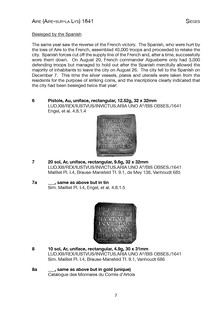
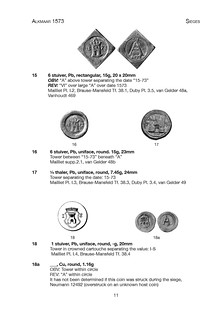
While siege money is emergency or necessity money, not all emergency or necessity money is siege money. Provisional coinage and money issued during transitions of sovereignty and monetary shortages are not siege money. For example, Mallorca produced the 1821 five pesetas during a quarantine of the island due to an epidemic of yellow fever. Also, in instances of economic instability, coins were sometimes counterstamped to indicate a change in value. However, while these extreme conditions produced emergency money, only sieges produce obsidional money.
Foreword
I began collecting siege money many years ago after acquiring a 1621 Julich four stuiver from a local coin dealer. The irregularly shaped coin sparked my interest and I wanted to learn more. However, when I began my search for information, I discovered that there were no catalogues and very few articles in English on the subject. Since this was pre-internet, my only avenue of research was to seek the available numismatic reference works in Latin and multiple European languages. Many of these references were difficult to find. However, once I found them, I added them to my library and discovered that each was incomplete on its own due to the complexity of the subject matter and the information available at the time of their publication. So, I began a numismatic journey that led me to this project. Siege Coins of the World. Siege Coins of the World is the result of translating the major works, merging their content, and updating the most recent information available into a single volume. It is an attempt to expand the knowledge of this fascinating area of numismatics and create a comprehensive English language reference for the collector.
Siege Coins of the World intentionally excludes fantasies and issues that are more appropriately categorized as necessity coins, such as Cartagena, Montalcino, La Rochelle, and Spanish local issues. Conversely, those generally accepted by the numismatic community as siege coins are included, such as Groningen, Thorn, and the Irish cities of refuge. Most, but not all, known varieties of each type are listed. The reader can find these varieties in specialized catalogues that are noted in the Selected Bibliography.
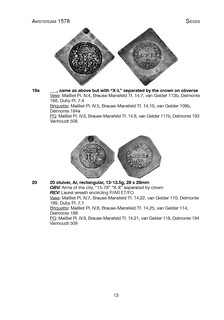
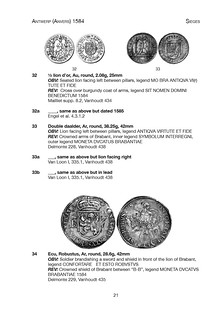
In Siege Coins of the World, sieges are arranged in alphabetical order for easy reference. There is a brief description of each siege to provide the reader with historical context followed by a list of coins known to be issued as a result of the siege. Siege Coins of the World has assigned a uniform numbering system and cross references to other cited sources. Coins that were missing from earlier works and major varieties that have since been confirmed have been added. Illustrations accompany the descriptions and line drawings are provided where no photograph was available. The reader should note that while the author has made every effort to provide precise specifications for each coin, slight variances in size and weight are not uncommon.
For more information, or to order, see:
Siege Coins of the World
(https://cngcoins.com/Coin.aspx?CoinID=394445)
NEW BOOK: BANKNOTE YEARBOOK 11TH EDITION
Token Publishing has announced the latest edition of the Banknote Yearbook. A digital version is available as well. -Editor
Banknote Yearbook 11th edition
£29.95
Release Date: Mon, 26 July 2021
 PRE-ORDER YOUR COPY TODAY! After a long coronavirus enforced delay the BRAND NEW 11th edition of the BANKNOTE YEARBOOK will be available very soon! At an impressive 568 pages this hardbound book is the perfect reference for all collectors of English, Scottish, Irish and Island banknotes with all the notes of the main banks (and the early Treasury notes) covered and illustrated in full colour. It includes a full price guide for all notes (most in three grades) and has been fully update in line with market movements. It also contains all the new issue notes from the past four years right up to, and including, the new polymer
PRE-ORDER YOUR COPY TODAY! After a long coronavirus enforced delay the BRAND NEW 11th edition of the BANKNOTE YEARBOOK will be available very soon! At an impressive 568 pages this hardbound book is the perfect reference for all collectors of English, Scottish, Irish and Island banknotes with all the notes of the main banks (and the early Treasury notes) covered and illustrated in full colour. It includes a full price guide for all notes (most in three grades) and has been fully update in line with market movements. It also contains all the new issue notes from the past four years right up to, and including, the new polymer Turing
£50 which features on the front cover. Retailing at £29.95 (plus p&p) the book is a must have for collectors; with the 10th edition having completely sold out this one has been very eagerly awaited – order your copy today and get it POST FREE (if ordered before July 30)
For more information, or to order, see:
Banknote Yearbook 11th edition
(https://www.tokenpublishing.com/shop/product/8065)

AINA FORUM: ANTIOCH AND JERUSALEM
Readers are invited to an AINA Forum featuring author Dr. David Jacobson. Here's the announcement. -Editor
Antioch and Jerusalem, the Seleucids and Maccabees in Coins
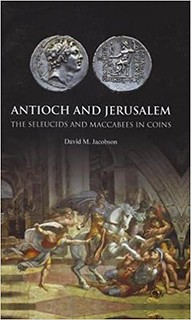 The next AINA (American Israel Numismatic Association) forum will feature Dr. David Jacobson, Associate of the Faculty of Oriental Studies Faculty, University of Oxford, and winner of AINA’s 2021 Shekel Prize Medal. The forum will be held jointly with the Anglo-Israel Archaeological Society. Jacobson’s talk will be about
The next AINA (American Israel Numismatic Association) forum will feature Dr. David Jacobson, Associate of the Faculty of Oriental Studies Faculty, University of Oxford, and winner of AINA’s 2021 Shekel Prize Medal. The forum will be held jointly with the Anglo-Israel Archaeological Society. Jacobson’s talk will be about Antioch and Jerusalem, the Seleucids and Maccabees in Coins,
the subject of his book with the same title. The zoom talk will take place on August 22 at 7 PM in England, corresponding to 2 PM EST, 11 AM PST, and 9 PM in Israel. To receive an invitation, email Simcha Kuritzky, President of AINA, at
amerisraelcoin@gmail.com.
Jacobson’s work recounts the heroic story of the Maccabees and explains how they successfully took on the might of the Seleucid realm, illustrated by the coins issued by the main protagonists. The author writes: What was an epic struggle of an oppressed people to win their national and religious freedom has provided much inspiration through the ages and continues to strike a strong resonance in our own times. However, the historical drama, as recorded in 1 and 2 Maccabees, with its unfamiliar roll-call of major players and place names, has acquired a considerable mystique. The coins put faces to many of these seemingly obscure names and help bring those stirring events back to life.
David Jacobson will show how, after the Maccabean leadership under Jonathan became accepted as part of the power structure of the Near East by his Seleucid rivals, he assimilated many of their political practices and cultural norms. This process is reflected in the Hasmonaean coinage from the time of John Hyrcanus I, which uses several of the same motifs and the identical denominational system.
Mel Wacks, President Emeritus of AINA, indicates David’s talk should be of great interest whether or not you collect ancient Judaean coins.
For further information about AINA, visit www.theshekel.org.
To read the earlier E-Sylum article, see:
DAVID JACOBSON WINS 2021 SHEKEL PRIZE
(https://www.coinbooks.org/v24/esylum_v24n11a07.html)
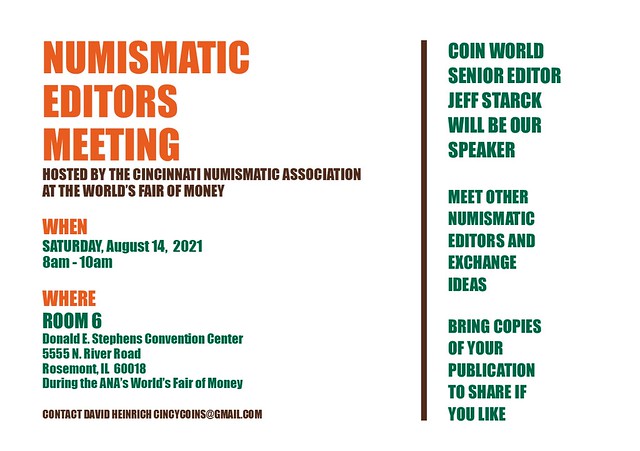
PONDERING PANDEMIC PUBLISHING
In his latest CoinUpdate Notes Published column, Dennis Tucker of Whitman Publishing ponders pandemic-produced publications in the numismatic world. -Editor
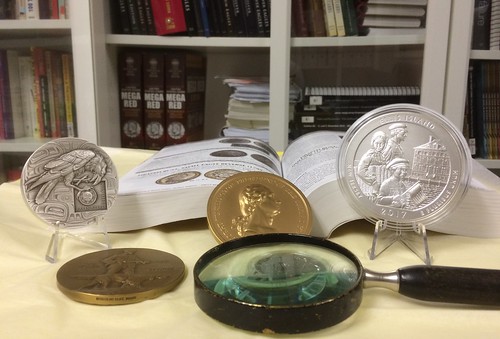
The Pandemic, and Writing Time
In recent months I’ve heard from many numismatists who tell me they’ve used the past year-plus of involuntary isolation to buckle down and catch up on research and writing.
Last week I talked with one writer about a project we first discussed eight years ago; he’s been tinkering with it over the years but is now working in earnest. (He wasn’t asleep at the wheel; he’s been active and publishing in other areas in the meantime.)
Research is ongoing in ancient coins, colonial and early American money, the historical technology of the United States Mint, coins and paper currency of various countries, market analysis, and many other fields.
The Newman Numismatic Portal—a publishing giant, even if it doesn’t print and sell books—continues to expand. Its current largest project in progress is the digitization of Numismatic News, a publication that will celebrate its 70th year in 2022. That project is about 80 percent complete as of June 2021.
Quite a few numismatists have used the time to catalog their coins, medals, and other treasures; start new collections; and work on organizing and displaying their current holdings.
Others have used their quiet time for introspection. I know of several numismatic autobiographies that are in various stages of completion.
What will come of all this focused activity? I predict that, starting over the next twelve to eighteen months, and possibly sooner, we’ll see an explosion of numismatic publishing—books, peer-reviewed articles, and the like—of work that was pushed to the finish line during the coronavirus pandemic. Kudos to all who are undertaking it.
To read the complete article, see:
Notes Published: The pandemic, and writing time
(http://news.coinupdate.com/notes-published-the-pandemic-and-writing-time/)
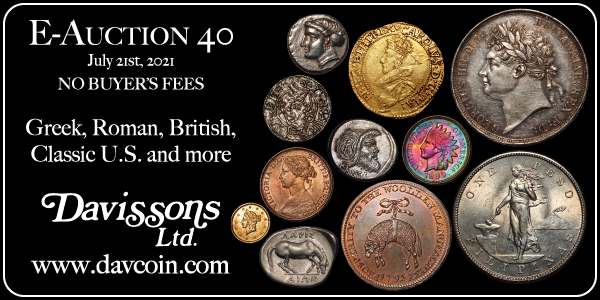
NUMISMATIC NOTABLES: KEN BRESSETT
The latest addition to the Newman Numismatic Portal is a video interview with Ken Bressett. Project Coordinator Len Augsburger provided the following report. Thanks! -Editor
Numismatic Notables: Ken Bressett
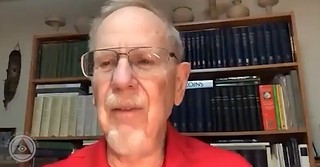 In honor of July 4, one of Ken Bressett’s favorite holidays, Newman Portal announces the second installment in its Numismatic Notables series. Bressett was interviewed by Len Augsburger and Joel Orosz on March 19, 2021 and this video is now available on Newman Portal. Bressett covers his early days as a collector, his extensive photo archive that he started in the 1940s, and his first contacts with Richard Yeoman, Guide Book of United States Coins founder.
In honor of July 4, one of Ken Bressett’s favorite holidays, Newman Portal announces the second installment in its Numismatic Notables series. Bressett was interviewed by Len Augsburger and Joel Orosz on March 19, 2021 and this video is now available on Newman Portal. Bressett covers his early days as a collector, his extensive photo archive that he started in the 1940s, and his first contacts with Richard Yeoman, Guide Book of United States Coins founder.
Bressett began submitting edits to the Guide Book in the 1950s and was soon hired by Whitman Publishing on a full-time basis. Later, Bressett worked for the American Numismatic Association in a variety of capacities. He continues today as Guide Book Editor Emeritus. This interview covers little-known aspects of Bressett’s career, including a number of important coins he handled from the Anderson DuPont collection. Bressett further summarizes important changes in the coin industry since his beginnings as a collector in the 1930s. With video production by Lianna Spurrier, this is a pleasant hour well-spent.
Link to Numismatic Notables: Ken Bressett on Newman Portal:
https://nnp.wustl.edu/library/book/601239

COINS THAT AREN'T WHAT THEY APPEAR TO BE
Newman Numismatic Portal intern Garrett Ziss provided the following article based on recently added digital content. Thanks! -Editor
Last week’s NNP E-Sylum article highlighted inquiries to the U.S. Mint that included pencil rubbings of Early United States coins. Three additional letters from the National Archives also contain pencil rubbings of numismatic items. Even though they are quite different from each other, they all fall under the category of Not What They First Appear To Be.
The fact that their identities are a bit unusual likely prompted their owners to seek help from the Mint.
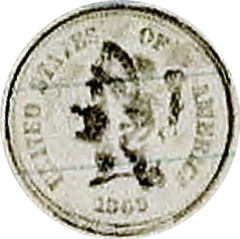

With only a quick look at the obverse, this coin might be mistaken for a three-cent piece. However, its slightly larger size and reverse design help to identify it as the 1869 pattern 5 cent piece (Judd-684). This coin was part of an effort to try to standardize the design of minor coinage in the late 1860’s. The Mint noted in the 1896 correspondence with its owner, J. Barnet of New York City, that this pattern was never issued [for circulation] and that the coin’s numismatic value was about 75 cents.

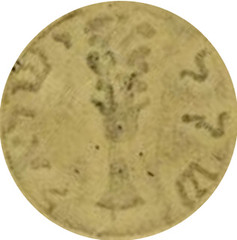
In 1894, Thad Burch, from Rich Hill, Missouri, consulted experts
, an encyclopedia, and the U.S. Mint, in order to determine what kind of coin
he owned. Even though all 3 sources pointed him toward the Jewish shekel, he was skeptical about this information. His instincts were correct, as the item is a false shekel, whose design is based on a shekel from the time period of the 66-70 AD Jewish revolt. This specific false shekel was produced about 1857.
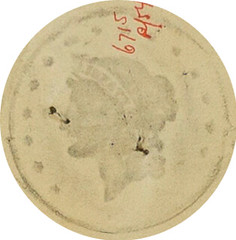
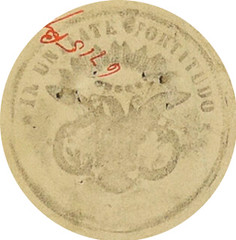
According to newspaper reports from the 1860s and early 1870s, the basic design of this numismatic item is similar enough to a Liberty Head double eagle that there were attempts made to pass it off as a gold coin to unsuspecting merchants. It’s clear that this specific object was meant to deceive because the German phrase spiel marke
, which indicates that it’s a gaming counter and not a gold coin, has been removed from the bottom of the obverse and reverse. The absence of this numismatic clue prevented Andrew B. Campbell of Vernon, Texas, from successfully identifying his item and prompted him to write to the Mint in 1888.
Link to letter with pencil rubbing of an 1869 pattern five cent piece:
https://archive.org/details/rubbingof1869patternfivecent18960212/mode/2up
Link to letter with pencil rubbing of a false shekel:
https://archive.org/details/identityrubbingjewishsheckel18940521/mode/2up
Link to letter with pencil rubbing of a gaming counter:
https://archive.org/details/designimitatingusdoubleeagle18881212/page/n1/mode/2up
To read the earlier E-Sylum article, see:
COIN RUBBINGS IN MINT CORRESPONDENCE ON NNP
(https://www.coinbooks.org/v24/esylum_v24n26a12.html)

VIDEO: JUDITH KAGIN INTERVIEW
These are selections from the David Lisot Video Library that feature news and personalities from the world of coin collecting. David has been attending coin conventions since 1972 and began videotaping in 1985. The Newman Numismatic Portal now lists all David’s videos on their website at:
https://nnp.wustl.edu/library/multimediadetail/522852
Here's an interview with dealer Judy Kagin. -Editor
Judy Kagin Continues Family Tradition in Numismatics with Paper Money.
VIDEO: 9:49.
 Judith Kagin, Owner, X-tremely Fine, Ltd,
Judith Kagin, Owner, X-tremely Fine, Ltd,
David Lisot, Interviewer, CoinTelevision.com.
May 6-8, 2021.
Judy Kagin’s father was A.M. Art
Kagin, one of the greatest numismatists of all time. Judy became interested in paper money and embarked on a career in the coin industry buying and selling some of the most beautiful notes ever made in the United States. She shares the story of her life and tales of some of her favorite bank notes.
An excerpt of the video is available for viewing on the Coin Television YouTube Channel at:
https://youtu.be/29dkpJOrD48
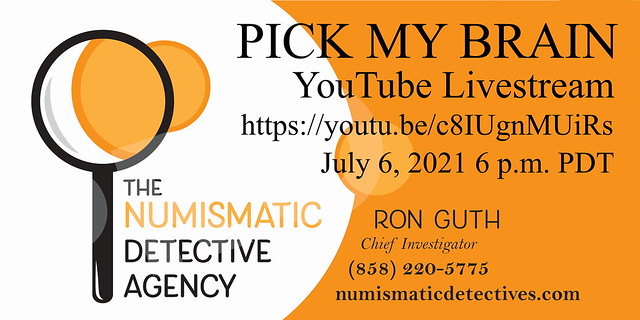
IAN RANK-BROADLEY STATUE OF PRINCESS DIANA
David Pickup writes:
"There are several stories in the press about the sculptor of the statue of Diana Princess of Wales on internet. He is also a coin designer. In 1997 he won the Royal Mint competition for a new effigy of Elizabeth II to appear on the obverse of circulated British and some Commonwealth coinage. He also designed the Queen Mother Centennial crown coin and the portrait of Elizabeth II and Prince Philip on the 2007 crown coin, celebrating their sixtieth wedding anniversary.
"The statue of Diana, unveiled on Friday, has had a mixed reception. His Armed Forces Memorial at the National Memorial Arboretum containing two large figure groups, comprising fourteen figures, each one and a quarter times life size is a powerful and dramatic piece of art earning him the 2008 Marsh Award for Excellence in Public Sculpture."

https://commons.wikimedia.org/wiki/File:Statue_at_the_Armed_Forces_Memorial_-_geograph.org.uk_-_1566956.jpg
Thanks. I located a couple articles with more information. The new statue features three children, but one is obscured by the angle of many of the photos taken of it from the front. Here's one picturing the sculptor and his work from a better angle. -Editor

The statue of Princess Diana was created by renowned artist Ian Rank-Broadley, whose image of the Queen's head has appeared on all coins in the UK since 1998, and who boasts an award-winning portfolio that also includes bronze male nudes.
The 69-year-old is one of the most renowned British sculptors, and produced a sculpture depicting the harrowing realities of war that became the focal point of the Armed Forces Memorial at the National Memorial Arboretum, Staffordshire.
Born in Walton-on-Thames, Surrey, the artist was educated at Epsom School of Art and the Slade School before continuing his studies at the British School in Rome.
In recognition of his talents he was made a Freeman of the Worshipful Company of Goldsmiths in 1996 and granted the Freedom of the City of London.
Among his royal connections, he is a trustee to The Prince's School of Traditional Arts, which was set up by the Prince of Wales in 2005.
His works are in the permanent collections of the British Museum, London's National Portrait Gallery, the Ashmolean Museum, Fitzwilliam Museum Cambridge and St Paul's Cathedral.
To read the complete article, see:
Renowned sculptor behind Diana statue: Gifted artist Ian Rank-Broadley whose portrait of the Queen is used on British coins boasts award-winning portfolio that also includes bronze male nudes
(https://www.dailymail.co.uk/news/article-9746371/Gifted-artist-Ian-Rank-Broadley-boasts-award-winning-portfolio-including-Diana-statue.html)
Another article has some great images of his work. -Editor
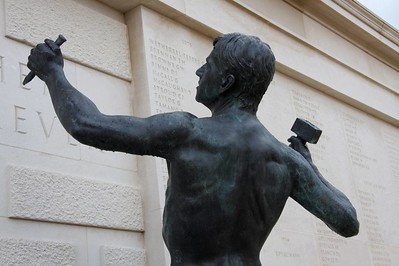

The making of images has been central to my life. From an early age a compulsion to render in three dimensions has been imperative. The art of creating an image, shaman-like, which would posses qualities that exist in real life translated into a permanent state, was of immense importance to me,
the artist writes on his website.
Throughout his career, Rank-Broadley has mostly created architectural and monumental pieces, some of political figures and religious figures. Working predominantly with bronze, he has also created granite and fibreglass pieces.
To read the complete article, see:
Who is Ian Rank-Broadley? Meet the sculptor behind London's new Princess Diana statue
(https://www.thenationalnews.com/arts-culture/art/2021/07/01/who-is-ian-rank-broadley-meet-the-sculptor-behind-princess-diana-statue/)

NOTES FROM E-SYLUM READERS: JULY 4, 2021
Quiz Answer: What's Wrong With These Coins?
"Regarding the US Mint & Coinage cover; Whew, These are pretty bad!
1. Lincoln Cents do not have a ring of dots around the edge on either side.
2. Kennedy half dollars do not have a ring of dots either, and genuine K. Halves have reeded edges, not plain.
3. The gold American Eagle does not have a ring of dots, it does have a ring of stars. The real gold American Eagles have a reeded edges. If it it supposed to be a double eagle, it should have stars not dots and a lettered edge."
Dave Lange writes:
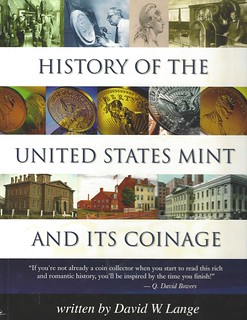 "I had to chuckle when I saw Bruce Bartelt's piece about my mint history book. Needless to say, I had no input into the cover design, which is entirely the product of Whitman's art department. I suspect those "coins" in the second row of illustrations may contain chocolate. I've told the story of this book's creation before, and it's been in The E-Sylum already, but I'll include a brief recap here.
"I had to chuckle when I saw Bruce Bartelt's piece about my mint history book. Needless to say, I had no input into the cover design, which is entirely the product of Whitman's art department. I suspect those "coins" in the second row of illustrations may contain chocolate. I've told the story of this book's creation before, and it's been in The E-Sylum already, but I'll include a brief recap here.
"It began as a correspondence course commissioned of me in 1995 or 1996 by the ANA's then education director, James Taylor. The history portion I wrote was to be combined with a section on current minting technology to be written by the late J. T. Stanton. For whatever reason, J. T. never delivered his chapters, and the whole project was abandoned when James left the ANA after being passed over for the executive director position. My manuscript was discovered a few years later by his successor, Gail Baker, who revived the project. The folks at the ANA liked it enough that I was asked to bring it up to date and add a few chapters so that it could be published by the ANA as a book rather than a correspondence course. A graphic designer who had done previous work for the ANA, Mary Jo Meade, was assigned to select images and put the whole thing together. Rudy Bahr of the ANA's staff would oversee its publication.
"The project was nearing completion when the ANA's executive director, Chris Cipoletti, purged a slew of people, Rudy included. At some point he struck a deal with Whitman Publishing to put out the book commercially. I heard about this only indirectly, as I was entirely out of the loop at that point. I first learned it was in print when I saw it for sale at the Whitman booth during a 2005 coin show. It came complete with a greeting from Cipoletti dated April of that year and titled "Discover and Explore the World of Money." The cover design was startling to me, but naturally I bought a copy of the book to inspect the finished product. I discovered a number of minor errors, mostly pertaining to the images, but otherwise it looked pretty good.
"After Chris Cipoletti's employment was terminated by the ANA a couple years later, a new printing was issued without his two pages. The graphic errors were fixed at the same time, though I don't believe this revised printing was labeled a second edition. The book soon became my best selling title, but I have no financial interest in it whatsoever. I had written it pro-bono on behalf of the ANA and have never sought compensation. I don't know how much was remitted to the ANA, but I imagine it must have benefitted in some way."
Interesting. I had no idea there was more than one version of the book. For grins, I'll keep my eye open for the other variant. -Editor
To read the earlier E-Sylum article, see:
NOTES FROM E-SYLUM READERS: JUNE 27, 2021 : Quiz Quiz: What's Wrong With These Coins?
(https://www.coinbooks.org/v24/esylum_v24n26a17.html)
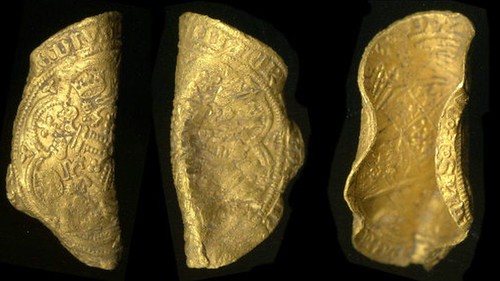
"I vote to UNFOLD the Edward III gold coin. I would if it were mine!"
Carl Honore, M.A. writes:
"One cannot "unfold" a coin or a piece of sheet metal or bar stock and obtain a close to original representation of the design. When a piece of metal is deformed by folding, the point of deformation undergoes tension on one side and compression on the other. Looking at the edge of a coin and imagining a fold, the top of the coin would be stretched, and the bottom of the coin would be compressed. This would occur whether or not the coin is heated prior to deformation. But the deformation is permanent. One could imagine in unfolding, the bottom of the same coin would be stretched, and the top compressed in this operation. But the point of deformation would be permanently and irrevocably deformed, and show a permanent loss of design at the "line" formed by the unfolding. In fact, at the atomic level, the entire coin deforms when one folds a piece of sheet metal or bar stock. At most, one could see part of the original design hidden by the fold, but that would be the best one could hope for."
Thanks for your comments. My vote remains to leave them as-is. -Editor
To read the earlier E-Sylum article, see:
NOTES FROM E-SYLUM READERS: JUNE 27, 2021 : Getting Bent and Unbent
(https://www.coinbooks.org/v24/esylum_v24n26a17.html)
Dave Hirt writes:
"I seem to find numismatic connected items. The latest is a coin plate. It has eight world coins embedded in a black 10" hard plastic plate. One of them is a British copper coin, with a portrait of a young Elizabeth II. The plate was made by a company in Calif. named COUROC. I have no idea of its age."

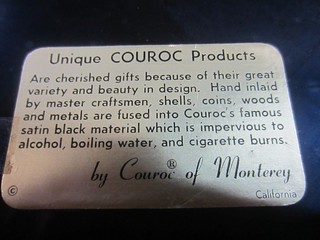
Online I found an image of a similar plate; separately I found an image of a product label identifying the producer as "Couroc of Monterey California" and stating "Hand inlaid by master craftsmen, shells, coins, woods and metals are fused into Couroc's famous satin black material which is impervious to alcohol, boiling water, and cigarette burns." Is anyone familiar with these? -Editor
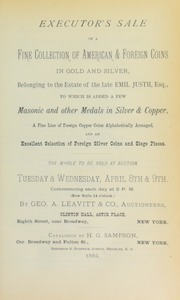 Dave Hirt writes:
Dave Hirt writes:
"Next is a question that perhaps one of our auction catalog collecting readers can answer. In a copy of H.G. Sampson's 13th sale, the Emil Justh collection, I found a one page separate addenda. I find no mention of this in any of the catalog reference books I have. Does anyone have information on this addenda? "Also I was glad to read the post on dealer Elmer Sears.I think that he is a underrated dealer. He handled many rare coins. I have two of his auction sales, and three fixed price lists. They offer many rare and interesting items."
The American Numismatic Society library copy scanned by the Newman Portal does not include an addenda. Can anyone help? -Editor
To read the catalog on NNP, see:
Executor's sale of a fine collection of American & foreign coins in gold and silver, belonging to the estate of the late Emil Justh ... [04/08/1884]
(https://nnp.wustl.edu/library/auctionlots?AucCoId=511616&AuctionId=512664)
To read the earlier E-Sylum article, see:
1796 QUARTER EAGLE EX-ELMER SEARS
(https://www.coinbooks.org/v24/esylum_v24n25a13.html)
Newman Numismatic Portal Project Coordinator Len Augsburger writes:
"A Newman Portal user seeks identification of this medal. A patriotic theme is no doubt intended, featuring a large eagle and a mounted military figure in colonial wear. The highly raised edge seems more contemporary with pieces of relatively recent origin. Can any E-Sylum readers attribute this piece?"


Unusual item. Can anyone help? -Editor
Dick Hanscom writes:
"I have an Alaska military token that is supposed to be either red or blue aluminum. It is just plain aluminum.
"Is it possible to remove the anodizing (is that the correct word) from the surface, leaving the plain aluminum pretty much unaffected?
"Inquiring minds want to know ;)"
I'm not sure of the correct terminology either. Can anyone help? -Editor
Jerry Fochtman writes:
"Apparently the image of S.B. Colby of registrar fame was used on a government bond. Wonder if any of the E-Sylum followers might know the specific bond/etc.?"
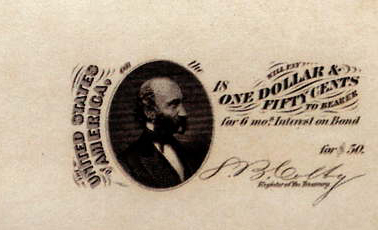
Can anyone help? -Editor
Anne Bentley of the Massachusetts Historical Society writes:
"LondonMudlark (@Lara Maiklem Mudlarking (London Mudlark)) Tweeted: I've cleaned up the silver coronation medallion I found on the foreshore a couple of weeks ago with a short burst of electrolysis in a bath of sodium bicarbonate solution then rubbed in a mixture of lanolin and soot added some toning."
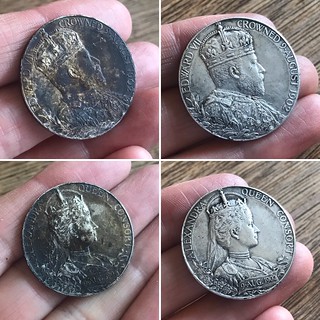
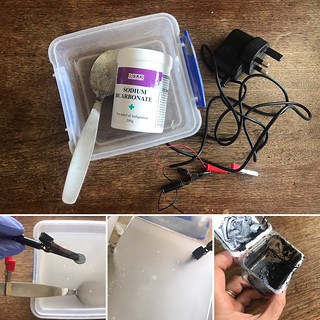
Anne adds:
"When I think of the months we spent removing the soot from our medals (old coal heat)!!!!"
See the article by Gary Beals elsewhere in this issue about a different cleaning method used on shipwreck coins. -Editor
To read the original tweet, see:
https://twitter.com/londonmudlark/status/1409765557918916611?s=27
Gary Dunaier writes:
"The auction for the pieces that flaked off a copy of Action Comics #1 was real. The name of the auction house that sold it is ComicConnect. Here's how they described it in their auction listing."
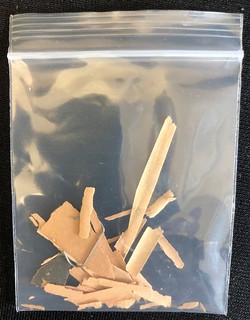 Own pieces of history! Pieces of Action #1 that flaked off as the consignor expertly separated an incomplete, brittle copy won in our auction and then CGC'd the pages; these are the first pages certified by CGC - includes a staple!
Own pieces of history! Pieces of Action #1 that flaked off as the consignor expertly separated an incomplete, brittle copy won in our auction and then CGC'd the pages; these are the first pages certified by CGC - includes a staple!
origin &1st app. of Superman by Siegel and Shuster
The most important comic book in history, Action #1 stands as the introduction of the archetype of all other heroes to come as Superman transcends comics and pop culture as an icon of truth, justice, and the American way!
Created by Jerry Siegel and Joe Shuster, Superman is quite possibly the most recognizable fictional character in the world. The brainchild of two struggling sci-fi fans from the Rust Belt, the Man of Steel became an instant icon to Depression-era readers and transformed into a symbol of national spirit and spunk during the brutal days of WWII. Since then, he has endured as both a beloved character and an embodiment of hope and vigor, making this first appearance not just a piece of comics' history, but of American history as well.
bag measures 2"x3"
Includes COA
Gary adds:
"As mentioned in the listing, it comes with a certificate of authenticity, which reads: "This certifies that to the best of the knowledge and expertise of the owners and staff of ComicConnect, the ACTION COMICS #1 Fragments Staple [sic] are authentic and genuine."
"The auction ended 12/16/20. There were 26 bids... it sold for $410."
Thanks! Will the future price leap tall buildings in a single bound? -Editor
To read the earlier E-Sylum article, see:
LOOSE CHANGE: JUNE 27, 2021 : Selling the Crumbs of Action Comics #1
(https://www.coinbooks.org/v24/esylum_v24n26a30.html)
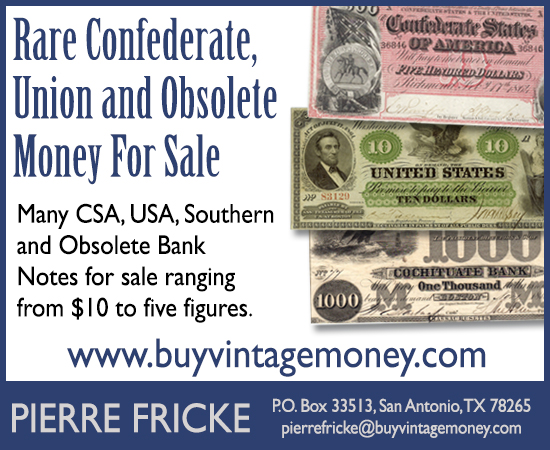
THE ROBERT S. CHAMBERLAIN COLLECTIONS
Scott Miller writes:
"Many medal collectors are familiar with the work of Georgia Stamm Chamberlain, but few realize that her husband, Robert S. Chamberlain also collected coins and medals. The collection can be found at the University of South Carolina. I recently came across a brief catalogue from the University of South Carolina Libraries."
Thanks! I wasn't aware of this. Here's an excerpt from the collection summary document. -Editor
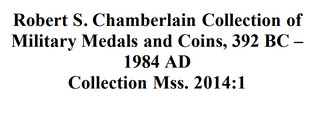 The Robert S. Chamberlain Collection of Military Medals and Coins contains
military medals, Greek and Roman coins, Civil War documents, and military figurines collected by the Latin American historian Robert Chamberlain (1903-1981), mostly during the late 1960s and 1970s. The collection also documents Chamberlain’s research in Hispanic American history during the colonial period and railroads.
The Robert S. Chamberlain Collection of Military Medals and Coins contains
military medals, Greek and Roman coins, Civil War documents, and military figurines collected by the Latin American historian Robert Chamberlain (1903-1981), mostly during the late 1960s and 1970s. The collection also documents Chamberlain’s research in Hispanic American history during the colonial period and railroads.
Robert Stoner Chamberlain was born in Canton, Ohio, on October 13, 1903. He received a B.A. in History from Stanford University in 1925, a B.S. in Education from Ohio State University in 1927, and a Ph.D. in History from Harvard University in 1936. He was a staff member in the Division of Historical Research at the Carnegie Institution in Washington, D.C. from 1936-1947. During the war years, he served as a cultural relations officer at the United States embassy in Guatemala City. He was an Associate Professor of History at the University of Miami, 1947-1948, and was in government service from 1948 until his retirement in 1965. His primary academic interest was Hispanic America during the colonial period. After retirement, he pursued his interests in Civil War history, collecting medals and coins, and doing some research on American railroads and trains.
Chamberlain gave this collection of medals, coins, and his personal papers to the University of South Carolina in 1979, together with his extensive Civil War library, presently housed in the Irvin Department of Rare Books and Special Collections, and his railroad library, which is housed in Thomas Cooper Library. Chamberlain was an acquaintance of Dr. Francis Lord of the USC history department, whose own Civil War collection was acquired by the university library in 1971 and gave Chamberlain the impetus to make the gift of his own collection to USC. Upon his son’s death in 1999, the Chamberlain estate came to the university library, which established the Chamberlain Endowment for Reference and Information Resources.
Series 1 contains 234 military and commemorative medals in boxes 1-4. The collection is organized geographically, and chronologically thereunder. It begins in the Americas, with restrikes of United States Congressional Gold Medals and Indian Peace Medals. These are followed by war medals, most commonly from the 19th century, representing countries and territories throughout North America, South America, Europe, and Asia. Most are original, though a few are restrikes or replicas and are noted as such below wherever known. Also included within the medals series are civilian issued awards for civil service and the commemoration of important events such as anniversaries and deaths.
Series 2 contains coins, the majority of which are from ancient Greece and Rome. From Greece, there are coins struck in Macedon and Egypt. Roman coins are from the Republic and the Empire and include coins struck at Alexandria while under Roman control. The date range of the Greek and Roman coins is approximately 336 BC – AD 305. Finally, there are several Hungarian and British coins from the 18th and 19th centuries, respectively.
Series 3 contains United States Civil War records of individual soldiers. These papers include a declaration for pension, discharge papers, and a service record. Also included is the diary of B. Peterson, 2nd Maine Battery, detailing his War experiences from January 5, 1864 – April 25, 1865.
Series 4 contains fifteen boxes of Chamberlain’s research materials. Part A: Medal Research contains seven boxes of documents related to the collecting and purchase of war medals. This part includes catalogs, lists, and records for the medals Chamberlain purchased.
Also included is occasional correspondence between Chamberlain and dealers related to the purchases and cancelled checks reflecting prices paid. Papers are arranged alphabetically. Following these materials is a box containing Chamberlain’s research, including his notes, correspondence with questions and answers, and copies of reference materials and articles. Papers are arranged alphabetically. Also in this box is information on the Orders and Medals Society of America.
For more information, see:
Robert S. Chamberlain Collection of Military medals and coins
(https://archives.library.sc.edu/repositories/5/resources/657)
Robert S. Chamberlain Collection of
Military Medals and Coins, 392 BC –
1984 AD
Collection Mss. 2014:1
(https://d2sw33r0wd4m0d.cloudfront.net/findingaids/rarebooks/
Robert%20S.%20Chamberlain%20Collection%20of%20Military%20Medals%20and
%20Coins,%20392%20BC%20%E2%80%93%201984%20AD.pdf)

AN ACT OF INDEPENDENCE: THE FIRST U.S. COIN
David McCarthy published an article in the May 2021 issue of The Numismatist about his discovery that within hours of receiving the news that the Revolutionary War had been won, the United States ordered its first coin to be struck. -Editor

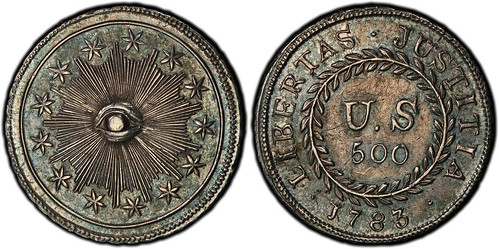
On Sunday, March 23, 1783, a French naval cutter made its way up the Delaware River, dropping anchor south of Independence Hall in Philadelphia. The aptly named Le Triomphe had set sail from Cadiz 36 days earlier, carrying news that Great Britain recognized the sovereignty of the United States. American independence had become a reality.
Reports that the war was over soon found their way to Superintendent of Finance Robert Morris, the nation’s chief executive and undoubtedly the most powerful man in Confederation-era North America. That evening, the financier was dining with John Barker Church, a successful merchant and brother-in-law to Alexander Hamilton. Church dashed off a letter to a business associate, recording that the news was first delivered to Morris at 6:20 p.m., writing, Ten minutes since the Captn. Of the Hyder Ally came to Morris’s...with the News that a General Peace was signed on the 20th of this Month.
Morris and his friends proceeded to Get Drunk as will many Christians who has [sic] this day been Piously Devoted.
The following morning, a jubilant Morris recorded in his diary, Yesterday we received the glorious News that a general Peace was concluded at Paris January 20th, 1783.
Over the next few hours, United States Secretary of Foreign Affairs Robert Livingston, General Horatio Gates and other luminaries visited Morris’s office to discuss the day’s events. Morris then attended to Various Applications for Money, Notes, Advice, Opinions &ca. &ca.
The final item in Morris’s diary on March 24—the first day that the U.S. government operated with the knowledge that the Revolutionary War had been won—may be our nation’s first sovereign act. Before leaving his office to attend one of the celebrations held that evening, the superintendent of finance recorded that he had Issued a Warrant on Mr. Swanwick in favor of B. Dudley £3.0.0.
B. Dudley
refers to Benjamin Dudley, a mechanic who had been hired by the United States to construct a mint for the new government, and the modest sum of £3 (the equivalent of eight Spanish silver dollars) was the final payment made to him before he delivered what Morris described in his diary as the first that has been struck as an American Coin.
Put simply, within 24 hours of learning that Great Britain recognized America’s independence, the man running the United States apparently ordered a government employee to strike the first U.S. coin.
[Pictured: THE 1783 PLAIN OBVERSE NOVA CONSTELLATIO—the coin that Robert Morris described as the first that has been struck as an American Coin
—was integral in establishing the system of money that we use to this day. Photos: PCGS COINFACTS.]
To read the complete article, see:
An Act of Independence
(https://www.money.org/act-of-independence)

REVOLUTIONARY THEMED NUMISMATICS
Unfortunately, the only images in this article are within the montage at the top, but it describes a number of great numismatic items associated with American independence. Happy 4th of July! From an unnamed author on the Stack's Bowers blog. -Editor
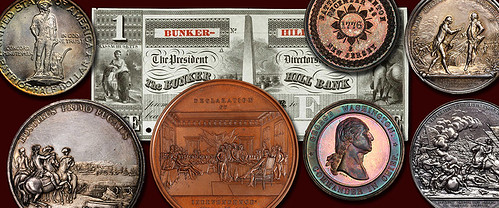
Independence Day is upon us once again. In this week’s blog, we are going to take a look at a few major battles of the Revolutionary War and the medals, currency and coins that commemorate them.
1. Lexington and Concord – Famous for the Shot heard around the World,
this Revolutionary battle was the first American victory. It pitted the American Minutemen against a very experienced British Army. The 1925 Lexington-Concord Sesquicentennial features a Minuteman on the obverse and the Old Belfry on the reverse. Old Belfry’s bell was rung on the morning of April 19, 1775, to alert the Minutemen that it was time to assemble for battle. As they say, the rest is history.
2. Siege of Boston – Following the battles at Lexington and Concord, the Continental Army was formed. They saw their first action in the month-long siege on Boston. The Continental Army sought to contain the British to the city of Boston and force their surrender. After the standoff, the British retreated to Halifax, Canada. The 1776
Washington Before Boston silver medal shows the seven British ships making their departure from the bay surrounding Boston. This retreat was a key victory for Washington and his troops.
3. On July 2, 1776, the Continental Congress approved the Declaration of Independence. Two days later, on July 4, 1776, it was adopted and signed by the Congress. It listed the reasons for separation from the British homeland. The famous signing of the Declaration scene is beautifully displayed on the reverse of the 1776
Charles Cushing Wright bronze medal.
4. The Battle of Bunker Hill was one of the first official battles of the American Revolution. Colonial forces captured Bunker Hill and withstood multiple attacks from the British. However, they ran out of ammunition and lost the third and final battle. While the Colonials lost the battle, the British lost a significant number of troops limiting their effectiveness going forward. The Bunker Hill Bank paper money shows the monument erected in commemoration of the battle. This note was produced by the New England Bank Note Co.
5. Several battles were fought between Bunker Hill and the Battle of Trenton, but this Christmas 1776 battle was key in the American Revolution. This battle was a very important morale boost for the beat up and knocked down American forces. You may know this battle from the famous scene of Washington crossing the Delaware River. The 1876 George Lovett’s Battle Series Number 8 medal commemorates this important victory. This So-Called dollar is shown in silver.
6. The Battle of Saratoga is considered the turning point of the revolution. In 1777, American soldiers surrounded the British forces in Saratoga, New York, cutting them off from escape. It was during this battle that foreign forces began to recognize the colonies as independent and gave their support to the American cause. The scene on the reverse of the 1777 Saratoga silver medal is powerful. It depicts the British General Burgoyne presenting his sword to General Horatio Gates. On the left of the medal, the British troops kneel and lay down their weapons. On the right side of the medal, the American troops stand at attention.
7. During the winter of 1777-1778, Washington and his troops camped at Valley Forge. They suffered from starvation and disease as they waited out the winter months. However, Washington was able to keep the support of his troops on the promise that the French were sending reinforcements to support the American cause. After a long, hard winter, the troops retook Philadelphia from the British. This 1878 Valley Forge Centennial medal in silver commemorates the departure from Valley Forge after the difficult winter.
8. The end of the war was near when the Battle of Cowpens, South Carolina took place. The American troops won South Carolina back from the control of the British army, setting in motion events that led to American victory and the end of the war. The back of this powerful medal shows Daniel Morgan leading his infantry on horseback while pushing the British army away. On the front, we see an Indian female (an allegorical figure representing America) crowning Morgan, symbolic of the victory won by America.?
To read the complete article, see:
Celebrate July 4th with Eight Revolutionary Themed Coins, Banknotes and Medals!
(https://www.stacksbowers.com/News/Pages/Blogs.aspx?ArticleID=celebrating-july-4-with-revolutionary-war-medals-and-coins)
THE BOOK BAZARRE
BORN ON THE FOURTH OF JULY
I'm no Yankee Doodle Dandy myself, but Happy Birthday to all those who are. Pete Smith submitted this list of numismatists born on the Fourth of July. Thanks! -Editor
These people, associated with numismatics, were born on the Fourth of July.
William Cutler Atwater was born on July 4, 1861. He was in the coal business. His collection included some choice rarities like a Brasher Doubloon and the Stickney 1804 dollar.
Shawn Duthie was born on July 4, 1964. He was named ANA Young Numismatist of the Year in 1982.
George Nicholas Eckert was born on July 4, 1802. He served as Director of the Mint 1851 to 1853.
Roland W. Finner Rollie
was born on July 4, 1934. He was the voice of public announcements at the
message center for Central States and ANA shows.
Frank Van Zandt was born on July 4, 1949. He served as Secretary-Treasurer of the Numismatic Bibliomania Society.
Are there others who should be included on this list?
We'll wrap up this section with a holiday greeting sent out by Robert Hoge. Happy Holiday to those of us in the U.S.A. And how about a Quick Quiz: which U.S. President(s) were born on the 4th of July? Which one(s) died on the 4th of July? -Editor
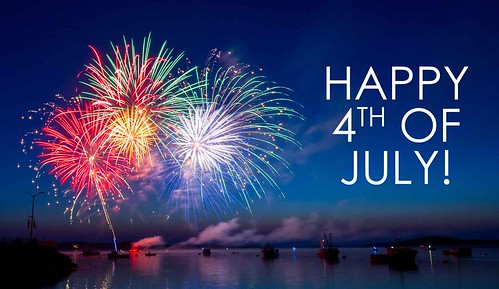

VOCABULARY TERM: ENGRAVING MASTER
Here's another entry from Dick Johnson's Encyclopedia of Coin and Medal Terminology, describing a likely obsolete yet still interesting part of the traditional engraving process - the engraving master. -Editor
Engraving Master. A metal pattern usually made by acid etching which serves as a template for engraving a design a metal object as a medal or plate by a pantographically on controlled surface engraving machine (see Gorton). An engraving master is required for a design other than letters (which can be engraved from stock template letters) – including monograms, signatures, logos and other nonletter designs. Engraving masters are made of metal, as copper, or any hard etchable material, even some plastics. The design is usually oversize, having been pantographically enlarged from original copy, it is incuse design as the channel in the master is what guides the tracer point to effect the engraving.
How engraving masters are made. From original black-and-white copy, as a drawing, signature or pasted-up mechanical, a film negative is shot, at which time the image is usually enlarged to perhaps two or more times original size. If necessary the film image is retouched – open spots in black areas are stripped in (with red stripping fluid) – unintended spots on clear film is scrapped off with a blade.
This film negative is then placed against an emulsion-coated metal plate (called a flat) and exposed to an arc light that transfers the image to the metal plate. Additional chemical coating makes the negative area impervious to acid etching; the positive area can then be acid etched. The depth of the etch is about .0040 (forty-thousandths of an inch). After the plate is cleaned and washed it is ready for use.
How an engraving master is used. The engraving master is mounted on the copy platform and locked in place in a tracer-controlled engraving machine. A tracing point is positioned in the channel at some outer point (it is not necessary to start in the center or at the upper left and move from left to right) – the operator may start at any outer position, checking his setting that the reduction ratio will permit the entire design to fit within the space intended on the object to be engraved. Some operators will make a full sample cutting in a clear plastic or Lucite; this is then laid over the intended object to insure the full design will fit the allowed space and it is positioned where intended (if not, the ratio is corrected).
The arm with the tracing point controls – in ratio and proportion – the arm with the cutting point. All design therefore is pantographically reproduced from incuse area of the engraving master to engraved design on the final metal surface.
To read the complete entry on the Newman Numismatic Portal, see:
Engraving Master
(https://nnp.wustl.edu/library/dictionarydetail/515856)

WILLIAM ELLIOT WOODWARD (1825-1892)
Here's another entry from the online draft of John Lupia's book of numismatic biographies. Thanks! This is an excerpt with the full article and bibliography available online. This week's subject is dealer W. E. Woodward. I added an auction cover image. -Editor
Woodward, William Elliot (1825-1892), He was born October 29, 1825 in Oxford, Maine, son of Captain Caleb Woodward and his second wife, Hannah Cary. During his early career he lived in Middletown, Connecticut, 16 miles south of Hartford where he was engaged in the insurance business. He married Clarissa Eliza Roys on June 26, 1848 while in Norfolk, Connecticut. That same year he moved opening the Mount Pleasant Apothecary Shop at 258-260 Dudley St. corner of Dearborn, Roxbury, Boston Highlands, Massachusetts. A pharmacist by trade he began collecting coins and other curios early on.
In 1851 they had a son born on April 12th whom they named Harlow Elliot Woodward. September 1856 they had a second son, Clarence Elliot Woodward. On February 3, 1858, W. Elliot Woodward became a member of the New England Historic Genealogical Society. Their third child Claribel only lived about 12 to 18 months and was buried on July 22, 1861.
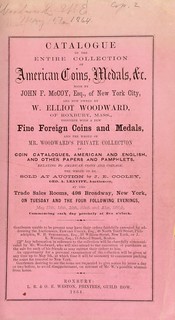 In the Fall of 1862 Woodward had his first semi-annual coin auction. In the summer of 1863, twenty-seven Oak and Pine Tree coins were unearthed in Roxbury. These came into the possession of J.N.T. Levick, and would appear at W. Elliot's auction the following year. In 1864 he purchased the coin collection of John R. McCoy, of Pittsburgh. This collection included the famous 1787 Brasher Doubloon.
In the Fall of 1862 Woodward had his first semi-annual coin auction. In the summer of 1863, twenty-seven Oak and Pine Tree coins were unearthed in Roxbury. These came into the possession of J.N.T. Levick, and would appear at W. Elliot's auction the following year. In 1864 he purchased the coin collection of John R. McCoy, of Pittsburgh. This collection included the famous 1787 Brasher Doubloon.
He was not only a collector and a dealer but also sold stamps, books, antiques and other collectibles and was a real-estate developer. His interest in books included reprinting antique documents and publication. In 1864 he reprinted Records of Salem Witchcraft, copied from the original documents, in two volumes. Also in 1864, he issued a Catalogue of a Choice Collection of American and English Books. In October 1864 he held his Fifth Semi Annual Sale.
In 1865, W. Elliot had printed two volumes by Franklin Benjamin Hough (1822-1885). One was "Washingtoniana or, Memorials of the death of George Washington, giving an account of the funeral honors paid to his memory, with a list of tracts and volumes printed upon the occasion, and a catalogue of medals commemorating the event." The other was "Bibliographical list of books and pamphlets, containing eulogies, orations, poems or other papers, relating to the death of General Washington, or to the honors paid to his memory." Also in 1865, he had published works edited by Samuel Gardner Drake (1798-1875). One was "Annals of Witchcraft in New England and Elsewhere in the United States, From Their First Settlement." Another was "The History of the Indian Wars in New England from the First Settlement to the Termination of the War with King Philip, in 1677."From the Original Work, by the Rev. William Hubbard, Carefully revisited, and accompanied with an historical preface, life and pedigree of the author, and extensive notes." In 1869 he published Bibliotheca Americana. In 1870 he published Henry Phillips, Historical Sketches of Paper Currency of the American Colonies Prior to the Adoption of the Federal Constitution.
On Sunday, January 3rd, 1892, W. Elliot contracted pneumonia. It plagued him for two days until culminating in cerebral paralysis. He died on Tuesday afternoon, January 5th, at his residence at 38 Harlow St, one block away from Woodward Park Street. His obituary stated that he is said to have been the best known coin dealer in the country and his series of coin catalogues is to be found in every large public library.
He was a corresponding member of the ANS and his death was cited in the report of the annual meeting on March 21, 1892.
Obituary,
Oswego Palladium, Wednesday, January 6, 1892; and in The Numismatist, No. 2, February (1892) on page 25. The Numismatist, Vol. 4, No. 6, June (1892) : 93; He died on the 5th of January, 1892 at his home in Roxbury, Massachusetts, at the age of 61.
His sons continued running his business after his death titled, W. Elliot Woodward Company, 40 Broomfield Street, Boston, Massachusetts, Buys and Sells Postage, Despatch, and Revenue Stamps. Coins, Medals, and Tokens. Rare Books, Pamphlets, and Newspapers; Autographs and Engravings; Historical Crockery; and Bric-A Brac and Curiosities of All Kinds.
The 1870 census valued his estate at $330,000.00. He cataloged 108 coin auctions in his career as a coin dealer from 1862 to 1890. A donor, in 1878, to the ANS library.
In November 1868 (81d) . Ebenezer Locke Mason, Jr. claims he never knew Woodward was a coin dealer. In 1867 he was the purchaser of the entire Mickley Collection at $14,000.00. Ebenezer Locke Mason, Jr. visited him on Christmas Day 1871. Around 1880 he discovered a hoard of 100 or so uncirculated Flowing Hair half dimes dated 1794. Woodward’s collection was sold by his company on October 13-18, 1884. On May 5th, 1885, W. Elliot's wife Clarissa was buried in the family plot. She was 56. Apparently, sometime within the next year, W. Elliot married Alice B., who was also buried in the family plot on July 4th, 1886.
To read the complete article, see:
WOODWARD, WILLIAM ELLIOT
(http://www.numismaticmall.com/numismaticmall-com/woodward-william-elliot)

MORE ON THE LAWRENCE BROTHERS
Pete Smith writes:
"The Lawrence Brothers were mentioned in recent issues of The E-Sylum. I dug through my files and found some related items."
Thanks! -Editor
Lawrence Brothers, twins Ray and Roy, were the sons of George C. Lawrence and Etta M. Pratt Lawrence. They had two older brothers. At the time of the 1940 Census, the twins lived with their parents.
DBA Lawrence Brothers, stamp and coin dealers. Publisher of Official Bureau Precancel Catalog. In 1946 the name was changed to The Coin Collector. The publication was sold to Ed Babka and The Coin Collector Publishing Co. of Kewanee, IL, in 1966. In March 1968 the publication was sold to Krause Publications.
Marion, Roy and Ray share a single headstone at Riverside Cemetery in Anamosa, Iowa.
 Lawrence, Ray L. Publisher (b. 5/22/1904 d. 4/16/1968)
Lawrence, Ray L. Publisher (b. 5/22/1904 d. 4/16/1968)
Twin brother of Roy. Attended Coe College, University of Minnesota and University of Iowa. Served during WWII. Employed with Internal Revenue Service 1943 to 1955.
Ray died in a hospital in Cedar Rapids, Iowa.
His obituary appeared in Coin World on May 1, 1968.
Lawrence, Roy C. Publisher (b. 5/22/1904 d. 10/27/1983)
Twin brother of Ray. He attended the University of Iowa. Married to Marian Card June 25, 1960. She
contributed cartoons to the paper. (She died July 31, 1981).
Publisher of Coin Hobby News after 1971 and Wall Street Tipster.
He died at home in Anamosa.
His obituary appeared in Coin World on November 16, 1983.
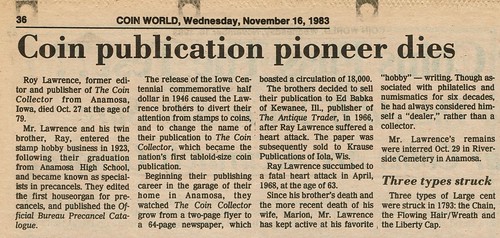
To read the earlier E-Sylum article, see:
NOTES FROM E-SYLUM READERS: JUNE 20, 2021 : Query: The Coin Collector
(https://www.coinbooks.org/v24/esylum_v24n25a08.html)
MORE ON THE COIN COLLECTOR
(https://www.coinbooks.org/v24/esylum_v24n26a15.html)

HARVEY STACK'S NUMISMATIC FAMILY, PART 99
The latest article in Harvey Stack's blog series wraps up the year 1985, including the Jimmy Hayes sale. -Editor
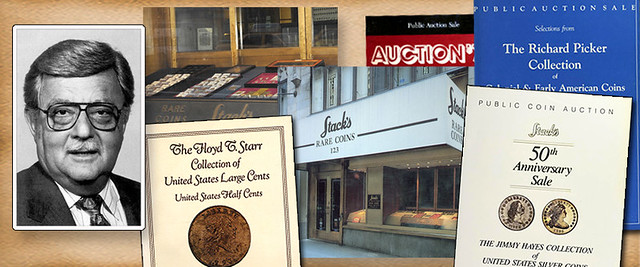
In September 1985, Stack’s auctioned 1,954 lots of very interesting coins from a variety of popular series. It provided a great chance for collectors to fill in the gaps.
Whether it was type coins from half cents to double eagles, Proof sets, or rolls of coins, one could find them in this comprehensive sale. It was a typical sale for Stack’s at the time, with consignments from a number of fine collectors, most of whom used our sales to gather funds for new purchases, to complete a collection or start a new series. This made our typical
sales very popular with both bidders and consignors.
And then, we moved into the 50th Anniversary Sale, a major offering and a great celebration. It took place over three days in October; there were three catalogs and each had its own focus. One had only 128 lots, all rare U.S. silver type coins from the Jimmy Hayes Collection. The second catalog offered coins from the Bartle Collection and the Carl Zelson Collection, 758 lots of choice and rare U.S. coins. The third and last catalog presented the Zurich Collection of Foreign Gold & Silver and English Gold & Silver Coins, 780 lots in total. Each session contained coins that were in great demand, attracting collectors and dealers from all over. The auction room was filled from start to finish and the prices realized reflected the importance of the event.
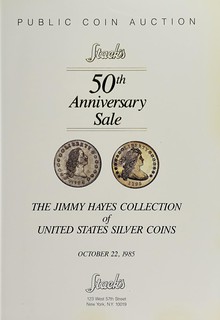 The first collection offered was famous as it had been formed by renowned collector and representative to Congress Jimmy Hayes. He had started collecting as a youngster when his family brought sacks of coins for him to go through to try to complete a collection. By the time he was in college his interests had turned to United States type coins, influenced by my cousin Norman’s book on the subject that explored some different ways to build such a set. Jimmy took Norman’s ideas and made them his own, deciding to collect the first year of issue of each change in design among United States silver coins. It made the task more difficult and more expensive, but Jimmy Hayes loved the challenge!
The first collection offered was famous as it had been formed by renowned collector and representative to Congress Jimmy Hayes. He had started collecting as a youngster when his family brought sacks of coins for him to go through to try to complete a collection. By the time he was in college his interests had turned to United States type coins, influenced by my cousin Norman’s book on the subject that explored some different ways to build such a set. Jimmy took Norman’s ideas and made them his own, deciding to collect the first year of issue of each change in design among United States silver coins. It made the task more difficult and more expensive, but Jimmy Hayes loved the challenge!
For the first year of each denomination there was a 1792 half disme, a 1794 half dime, a 1796 dime and quarter, a 1794 half dollar and silver dollar (in this case the Lord St. Oswald specimen). Then followed examples for the first year of each new design, mostly in outstanding gem Mint State. This was a very special type set and Jimmy showed the collection at coin shows and clubs around the country. When Stack’s offered him a stand-alone catalog in the 50th Anniversary Sale he agreed. The catalog was very special, and the sale was a great success.
After the Jimmy Hayes coins were offered, the second part of our 50th Anniversary Sale began with The Bartle Family Gold Coin Collection, highlighted by comprehensive collections of gold dollars, quarter eagles, three-dollar gold coins, early and later half eagles and eagles, and a wide selection of double eagles, as well as both types of $4 gold Stellas. In addition, we offered the Carl Zelson Collection of United States Coins that featured many Mint State pieces and was highlighted by an original run of early Proof sets, 1858-1900, sold by the year.
On the third and final day of the sale, we offered collectors of world coins the Zurich Collection, an extensive cabinet, mainly of pieces from medieval times up through the early 20th century. There was an extensive group of English coins that included a number of Coronation sets from the 18th to 20th centuries. There were many great sets and many great rarities.
Our final sale of the year, in early December, featured 1,737 lots of collector coins across many areas of numismatics, both United States and foreign items. Once again, this was a Stack’s sale that had something for everyone and was a great ending to 1985, a year of great achievement that was going to be hard to exceed.?
I reached out to Jimmy Hayes for his thoughts, wondering if he'd attended the sale. -Editor
He writes:
"I did attend the sale. I might add that the gold collection mirrored the concept of the silver collection. It was sold in part privately and in part in a few public auctions. The ANA exhibit of the Type Set this August has ten or twelve ex-Hayes coins. The 1808 quarter eagle ex-Judd and the 1796 proof dime are among them."
I'm looking forward to seeing that exhibit in Rosemont - see the earlier E-Sylum article for more information. -Editor
To read the complete article, see:
Harvey Stack Remembers: Growing Up in a Numismatic Family, Part 99
(https://www.stacksbowers.com/News/Pages/Blogs.aspx?ArticleID=harvey-stack-remembers-part-99-stacks-bowers-galleries)
To read the earlier E-Sylum articles, see:
HARVEY STACK'S NUMISMATIC FAMILY, PART 98
(https://www.coinbooks.org/v24/esylum_v24n25a16.html)
TYRANT COLLECTION U.S. TYPE COIN ANA EXHIBIT
(https://www.coinbooks.org/v24/esylum_v24n23a07.html)

THE IRV RATCLIFFE MORMON AND UTAH COLLECTION
Bob Campbell's All About Coins Inc, will be selling the Irv Ratcliffe collection of Mormon and Utah medals and trade tokens at the September 3, 2021 NATCA convention in Salt Lake City. With permission, here's an article about Irv from the July 2021 issue of The Mint Master from the Utah Numismatic Society. -Editor
Irvin Hale Ratcliffe was born in 1930 in Roanoke, Virginia. As the third of eleven children he learned to work hard at an early age. When he was ten years old, one of his chores included walking some distance to a neighbor's house to buy milk. His mother would provide him with Indian Head Pennies, Buffalo Nickels, and the occasional Standing Liberty Quarter. Irv was fascinated with these older coins.
Money was very tight at the Ratcliffe farm. but on rare occasions his mother would give him an old well-worn coin. lrv treasured these coins and the special bond with his mother, and it was at this young age that his interest in collecting started. However, Irv did comment that as a youth his collection was always safe until summer arrived and the ice cream man came by the farm.
Irv moved to Utah during his youth and was educated at Weber College (Weber State University) in Accounting and Social Work. He was a devoted husband and father to his four children. Irv's interest in collectables continued after working with Alvin Rust at Chevron, Standard Oil of California. Alvin left to start his own coin shop and Irv became a regular customer and life-long friend. Irv originally loved Lincoln Pennies and Morgan Dollars, but his interests soon expanded to include plates, watches, tokens, and memorabilia from The Church of Jesus Christ of Latter-day Saints. Irv frequently commented that his biggest issue with collecting was not being able to focus on any single group of collectibles. He had a passion for history and loved being able to hold pieces of it in his hands.
A key part of Irv's passion for collecting was the knowledge he gained and adventures he experienced tracking down his next purchase. He loved researching historical data and visiting unique locations throughout Utah and the western United States. Saturdays were generally reserved for trips that were in part history lessons and treasure hunts. He was as excited about finding a new item as he was about finding a better-quality version of a piece he already owned.
He was also passionate about his coin club membership and was President of the Utah Numismatic Society in 1974. He attended the first meeting of the National Utah Token Society on January 27, 1982 and had genuine pride in his collection of "NUTS" medals. Irv was also able to share his talent when he was asked to be on the committee designing the Bountiful, Utah medal celebrating 150 years as a City in 1997.
Irv loved to share his knowledge about coins, tokens and other collectibles. He frequently exhibited portions of his collection and won 1st Place, People's Choice, and Best in Show multiple times. Irv didn't discuss his awards or display them, but he would often talk about the people he met. However, many people may actually know his wife Danny better because Irv would bring her to the exhibits and then leave her in charge while he went off scouting for his next great acquisition.
Irv commented that he was never more comfortable than when he was with his fellow hobbyists and he took great pride in helping other people learn more about collecting and collectibles. The Ratcliffe Family would especially like to thank Bob Campbell for helping put together this auction. Bob started attending, U.N.S. meetings when lrv was President and Bob was a mere teenager, and the two have always had a special bond.
The Ratcliffe Family
For more information on the clubs, see:
Utah Numismatic Society
(https://www.facebook.com/UtahNumismaticSociety/)
The National Token Collectors Association
(https://www.tokencollectors.org/)
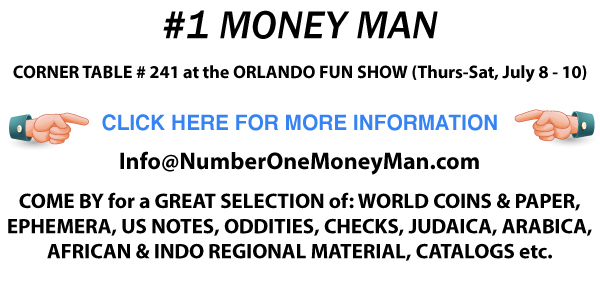
NGC PARENT CERTIFIED COLLECTIBLES GROUP SOLD
I'm sure everyone reading this issue has already heard this news, but I thought I'd be remiss in not including it given all of our past discussion on the rise of sports card collecting and the recent purchase of PCGS parent Collectors Universe. Here's Thursday's press release from PCGS rival Certified Collectibles Group, parent of NGC - they've been purchased by another Wall Street investment firm. -Editor
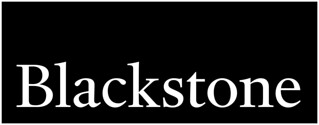
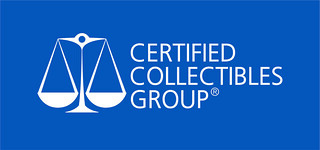
Blackstone (NYSE:BX) announced today that funds managed
by its Tactical Opportunities business (Blackstone
) have agreed to acquire a majority stake in the
Certified Collectibles Group (CCG
) in a transaction valuing the company at more than $500 million.
Mark Salzberg, CCG’s founder, and Steven R. Eichenbaum, CCG’s CEO, will retain a significant
minority stake. Additional investors in today’s transaction include Roc Nation; Michael Rubin, founder
and executive chairman of Fanatics; SC.Holdings, a growth equity platform; Mastry, founded by Rudy
Cline-Thomas; Andre Iguodala; Daryl Morey, President of Basketball Operations for the Philadelphia
76ers; and Main Street Advisors, a leading investment advisory firm to prominent athletes, recording
artists, and other leaders across entertainment and business.
CCG is a leading, global provider of expert, impartial and tech-enabled services that add value and liquidity to collectibles. Founded in 1987, CCG offers authentication, grading and conservation services that have unlocked billions of dollars in secondary market value. Today, CCG sits at the forefront of the fast-growing global collectibles industry with offices on three continents, robust digital offerings and comprehensive certification services for collectibles.
Blackstone will seek to accelerate CCG’s growth, enabling the company to invest significantly in its current and planned services, adding and training new employees, expanding its geographic and product reach, acquiring new technologies and developing its digital presence. Blackstone is one of the world’s leading investment firms with nearly $650 billion in assets under management and a strong track record of creating value and a positive impact for the companies it acquires and the communities that they serve.
C. C. Melvin Ike, Principal at Blackstone, said: As thematic investors, we look for exceptional
entrepreneurial teams succeeding in growing markets, and CCG is a great example. We have been
closely following the rise of the global physical and digital collectibles industry for several years and we
were drawn to CCG because of their leadership role in the categories that they serve, and Blackstone’s
ability to grow the platform through both organic and inorganic initiatives. We look forward to working
together to help the company continue and even accelerate its impressive growth trajectory.
CCG’s leadership team will remain in place, combining their experience and expertise with Blackstone’s extensive resources. Over the last 35 years, CCG has expanded from collectible coins to comic books, banknotes, magazines, concert posters, stamps, trading cards, sports cards and estate items. CCG has certified more than 62 million of these collectibles, with a combined fair market value approaching $50 billion.
Mark Salzberg, founder of CCG, said: When I established CCG, I had a vision that we would transform
collectibles into an asset class that is trusted by collectors, dealers and investors around the world. It
has been incredible to be a part of this journey as we achieved and then exceeded these goals. I am
excited to join with Blackstone as we enter the next phase of growth for CCG and the collectibles
market.
We are thrilled to be partnering with Blackstone during this key point in the industry as the collectibles
market continues to accelerate and attract new collectors and investors,
added Steven R.
Eichenbaum, CEO at CCG. From the moment we met the Blackstone team, we could tell that we
shared the same vision for the future of our company and the global collectibles industry.
To read the earlier E-Sylum article, see:
PCGS PARENT COLLECTORS UNIVERSE PURCHASED
(https://www.coinbooks.org/v23/esylum_v23n49a11.html)
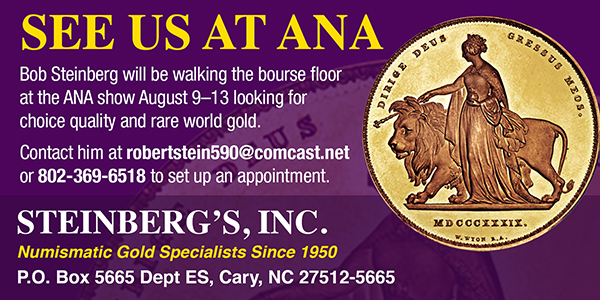
NUMISMATIC NUGGETS: JULY 4, 2021
Here's a selection of interesting or unusual items I came across in the marketplace this week. Tell us what you think of some of these. -Editor
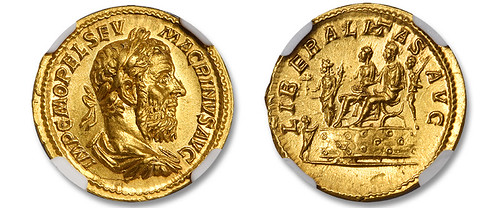
Our upcoming Official Auction of the ANA World's Fair of Money will present a tremendous array of stunning ancient coins emanating from various well-cultivated collections. A standout among them is a dazzling and lustrous gold aureus of Roman emperor Macrinus, who reigned briefly in A.D. 217-218 during a chaotic time in Rome's history. This stunning example, quite likely the finest of the type—or of any gold issue for the emperor—presents an exacting, razor-sharp strike that is so well centered that the beading of the borders on each side is wholly contained upon the flan.
This piece is in the upcoming Stacks Bowers auction. It was discussed in a blog article by Senior Numismatist and Cataloger Jeremy Bostwick. -Editor
To read the complete article, see:
Stunning Aureus of Macrinus – A Connoisseur's Dream
(https://www.stacksbowers.com/News/Pages/Blogs.aspx?ArticleID=choice-ms-aureus-of-macrinus-stacks-bowers-galleries-august-showcase-auction)
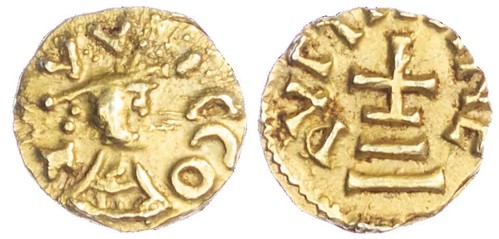
Merovingians, Quentovic (c. 620-640 AD), gold Tremissis, moneyer Dutta, VVICCO, diademed and draped bust right. Rev. DVTTA mOHET, cross set on three steps, 1.25g (NM Type 20-3A; Belfort 4960).
An unusual crude piece from Baldwin's. -Editor
To read the complete lot description, see:
MEROVINGIANS, QUENTOVIC (C. 620-640 AD), GOLD TREMISSIS – RARE
(https://www.baldwin.co.uk/product/merovingians-quentovic-c-620-640-ad-gold-tremissis-rare/)
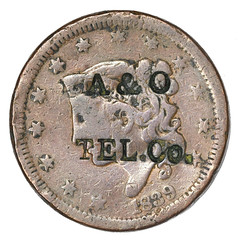
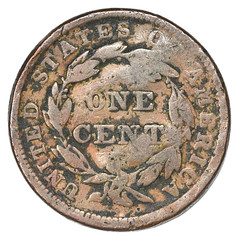
1839 U.S. Large Cent
Countermarked "A & O / TEL. Co."
Brunk A-15.
This is an issue of the Atlantic & Ohio Telegraph Company. This company operated in Pennsylvania.
Ex. Q. David Bowers collection.
From Bob Merchant's latest eBay offerings. I'm not sure if I've even seen a counterstamp from a telegraph company. Neat item. See Bob's great research notes on the history of the company and the development of the communications industry in the U.S. -Editor
To read the complete lot description, see:
1839 Large Cent, Counterstamp "A & O / TEL. Co" (Atlantic & Ohio Telegraph Co.)
(https://www.ebay.com/itm/133799993553)


EP-8, HB-67, S-38. Reed-BU01. One Cent. F. BUHL & CO., Detroit. Choice About Uncirculated.
Rated as Rarity-8 (5 to 10 known) according to Fred Reed. A wonderful opportunity to acquire one of the finest known. This high quality example has an attractive deep blue fully original Benjamin Franklin stamp that is well centered, if just a touch high. It is seen under clear mica that is unbroken and near perfect. The case is natural chestnut color with choice sharp legends. There are subdued traces of golden luster seen within the reverse. Previous examples include our EAHA Auction of August 27, 2005, The Dr. Gratz Collection Sale lot 831 graded Choice EF sold at $5,605; our EAHA Auction of April 25, 2014 lot 4, also graded Choice EF, sold for $4,130. This current One Cent F. Buhl & Co. is actually superior.
From the July 24th Early American History Auctions sale. I've always enjoyed collecting encased postage stamps, and this is a nice one. Buhl is a very scarce merchant. -Editor
To read the complete lot description, see:
Important One Cent F. Buhl & Co.
Detroit Rarity-8
(https://www.earlyamerican.com/Auctions/ClientPages/lots.item.php?auction=7&lot=199)

New York Central Railroad Company, 50 Cents, U.S. Postage Stamp Envelope, Full Complete Envelope with Top Flap, Choice Near New.
Printed in black ink on clean choice wove buff paper and reads: U. S. POSTAGE STAMPS. / 50 Cts. / N. Y. CENTRAL R. R. CO.
A stunning lovely example with a very impressive full and complete appearance. The highlight of this U.S. Postage Stamp Envelope section and the Finest Known. Original gum for sealing remains perfectly intact on the top flap. An extraordinary highlight for any advanced collection. Ex: Boyd/Ford Collection, Part 19, October 11, 2007, Lot 33 (no lot tag).
Another great piece of Civil War numismatica from the July 24th Early American History Auctions sale. Postage stamp envelopes are historically important and rare as hen's teeth. This piece is from the F.C.C. Boyd collection via John Ford. -Editor
To read the complete lot description, see:
Magnificent New York Central Railroad Company
50 Cents U.S. Postage Stamp Envelope, Choice Near New
(https://www.earlyamerican.com/Auctions/ClientPages/lots.item.php?auction=7&lot=191)
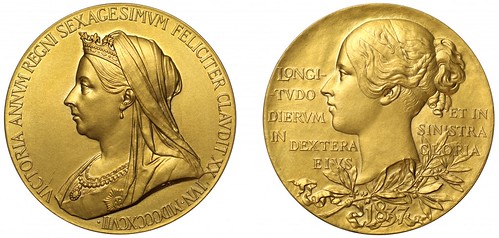
Diamond Jubilee of Queen Victoria, 1897, large gold medal by G W de Saulles after T Brock and W Wyon, veiled bust left, VICTORIA ANNVM REGNI SEXAGESIMVM FELICITER CLAVDIT XX IVN. MDCCCXCVII., rev. young head left, on laurel, LONGITVDO DIERVM IN DEXTERA EIVS ET IN SINISTRA GLORIA, 1837, 56mm, 88.88g (BHM 3506; Eimer 1817a). Extremely fine.
Offered by Sovereign Rarities. -Editor
To read the complete item description, see:
DIAMOND JUBILEE OF QUEEN VICTORIA, 1897.
(https://www.sovr.co.uk/diamond-jubilee-of-queen-victoria-1897-fm18758.html)

ROMAN COIN FIND: SAFE CROSSING OFFERINGS
The University of Leiden published an article about an interesting find of Roman coins believed to be offerings for the safe crossing of a river. -Editor
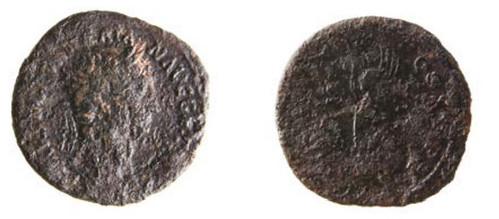
Several years ago, two amateur archaeologists from Brabant discovered over a hundred Roman coins near to Berlicum in the north of the province. After years of research, it now appears that the location, close to a ford in the river, was a site for offerings. Another interesting fact is that the coins offered were chosen very precisely. ‘This was an important eureka moment in my academic career.'
What made you conclude that this must have been a site for offerings?
Claes: ‘You can determine from different characteristics that this was not a hoard of valuable treasure that people deliberately buried for later. With finds like that, the coins would be in a chest or amphora, but that wasn't the case here. These coins were lying spread over a large area and were just loose in the earth. Also, they turned out not to be particularly valuable coins. What we found were mainly bronze coins; there were no gold ones, for example. That's not what you'd expect if the find were a treasure trove. Finally, the coins were from a very broad time period: the oldest coins date from the Republic [up to 27 BC, Ed.] and the most recent from the time of Emperor Marcus Aurelius [up to 180 AD]. This indicates that the coins must have been deposited by different people over a long period.'’
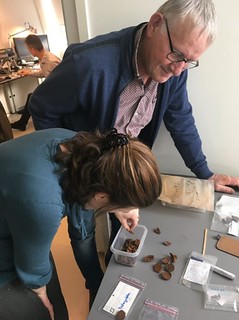 What was the deciding factor?
What was the deciding factor?
‘In the 1832 entry in the land registry - one of the Netherlands' oldest detailed maps - my colleagues noticed that at that time there was a path cutting across the river. Apparently there was a ford on this spot, where people could wade through the river. Later, the ford fell into disuse. This information, together with the find of the coins, convinced us that travellers in Roman times brought offerings here for a safe crossing. It may not have been a particularly rapidly flowing river, but for traders in particular it was important to be able to transport their goods safely to the other side. And there's also the fact that in ancient times rivers always had some sacred connections.
What surprised you most about this site?
‘I was mainly involved in studying the coins themselves. I looked at whether the travellers selected particular coins for their offerings. It seems that they did: coins with military imagery seemed to be popular offerings. Initially, I thought that was odd, because what does a military image have to do with a safe crossing? But then I realised that this was also quite common before Roman times: we regularly find offerings of axes, swords and helmets in other rivers and stretches of water. This could be a pre-Roman custom that continued in the Roman period but in a different way. That was an important eureka moment in my academic career.'
Found via The Explorator newsletter. To subscribe to Explorator, send a blank email message to: explorator+subscribe@groups.io. -Editor
To read the complete article, see:
Hoard of Roman coins turns out to be offering for safe crossing
(https://www.universiteitleiden.nl/en/news/2021/06/roman-coins-as-offering-for-safe-crossing)
THE BOOK BAZARRE
OLD WELL BENEATH HOME YIELDS OLD COIN
This Daily Mail story passed along by Erik Goldstein is more interesting for where an old coin was found than the coin itself. Thanks. -Editor
 A grandfather who spent the last decade digging out a 17ft-deep medieval well in his living room floor has found a coin from 1725.
A grandfather who spent the last decade digging out a 17ft-deep medieval well in his living room floor has found a coin from 1725.
Colin Steer, 70, discovered the well after he noticed a dip in the floor of the living room in his Victorian home in Plymouth, Devon, while redecorating 34 years ago.
At the time he had three small children running around so his wife Vanessa asked him to cover it back up, but when he retired in 2012 he took it on as a project and started digging.
Mr Steer discovered a sword five feet below the soil, leading him to believe it could date back to medieval times, and he said site plans suggest record of the well in the 1500s.
He recently found a coin from 1725 and hopes to eventually extend the walls of the well up into his living room to create a feature coffee table.
'I think it would be a great feature for our front room,' he said. 'We still aren't really sure about why the well is there.
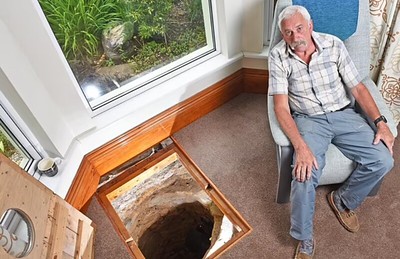
The hole is currently 17ft deep and there is about another four or five-foot that I want to dig out when I eventually get round to it.'
He said there is 4ft of water at the bottom of the well currently 'so everything that I dig out now will be wet and mucky stuff'.
 The 17ft hole in the couple's living room is currently covered over by a sheet of Perspex and a trap door.
The 17ft hole in the couple's living room is currently covered over by a sheet of Perspex and a trap door.
The couple's grandchildren love to look down the hole through the sheet of Perspex and Mr Steer said it was a great talking point with his neighbours.
He added: 'It is a good thing to show off to people as it is not something that you see every day. I have actually even tried some of the water that is at the bottom of the well. It was really clear and tasted fine to me.
Erik adds:
"Of course, the coin can’t be from 1725, being a very well-worn Young Head
Irish farthing of George II. And the wish
couldn’t be 300 years old, since this coin was subjected to many years – if not decades - of wear before going into the well."
To read the complete article, see:
Grandfather, 70, who discovered 17ft medieval WELL under his living room finds 1725 coin that was tossed in... but did the 300-year-old wish come true?
(https://www.dailymail.co.uk/news/article-9732709/Grandfather-70-discovered-17ft-medieval-living-room-finds-1725-coin.html)
THE HORROR OF DRUM-POLISHED EIGHT REALES
Gary Beals submitted this article on a thankfully obsolete method of cleaning shipwreck coins. Thanks! -Editor
Oh, the horror —
The 1970s and 1980s — when 8 reales coins recovered
from 1622 wrecks were drum-polished to a high sheen!
A 1986 National Geographic television documentary shows recovered coins being tumbled in a pebble polishing drum accompanied by chemicals and hundreds of ball bearings. The sound on the documentary of those rare Spanish colonial coins and ¼-inch stainless steel ball bearings being tumbled is terrorizing to any serious coin lover. And to think that those coins may have spent hours in this metal drum being battered against its sides, with steel balls is a nightmare. As the camera zoomed in, the voice-over noted that the pieces were gleamingly shiny — just what the salvors wanted. There are still shots captured from the program:
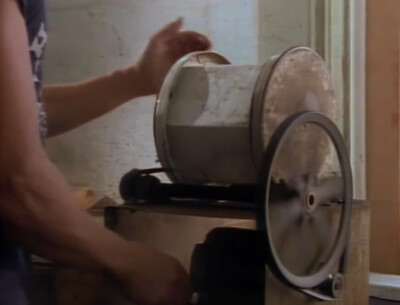
Thousands of the silver coins from the 1622 wrecks had yet more torture to endure at an artifact restoration (if that is the right word) lab. Specifically, silver 8 reales and 4 reales coins from portions of the Nuestra Señora de Atocha wreck found in the early 1970s.
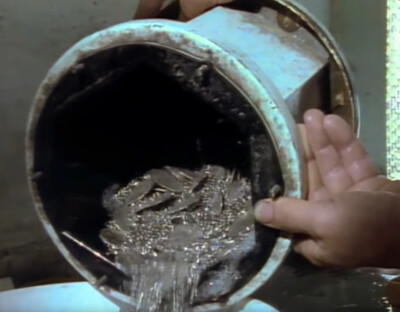
The drum of death — this device was a key tool is preparing coins for market from the mid-1970s until well into the 1980s. It belongs at the gift shop of a rock shop outside of Tucson helping to sell shiny agate pebbles to kids, not clanging cobs around in a caustic soup for hours.
Treatment in the drum completed, the 400-year old coins and the ball bearings were dumped from the drum and further sorted. The documentary noted the pieces received a Final rinse and polish.
Oh, yes don’t forget about polishing those 400-year old coins silver coins to a high gloss!
This treatment came after an electrolysis process, considered a quick and efficient way of cleaning corrosion off coins at the time. One specialist said: Electrolysis can clean a coins so well that it will reveal pitting and scarring that may not have been visible under the dirt or patina. Even the best zapped coin takes a lot of work, and specialty tools, to complete the "after-electrolysis" cleaning and final preservation.
The only good news here: The Mel Fisher company stopped doing this sometime after 1986. Some auction houses have mentioned that the particular 8 reales pieces being sold were of a later date of discovery or processing and did not receive this treatment. But it appears that thousands of silver pieces suffered this fate for at least a decade.
Where the numismatists were back then with coin treatment advice for the Fisher family is not known. An earlier National Geographic documentary in 1976 did not mention this process in its coverage of the impressive research and effort of the firm.

U.S. COAST GUARD SILVER MEDAL
Mike Unser wrote an article for CoinNews.net on the new U.S. Coast Guard 2.5 Ounce Silver Medal. Great looking piece! Congrats to the designers and engravers. Great team effort. -Editor
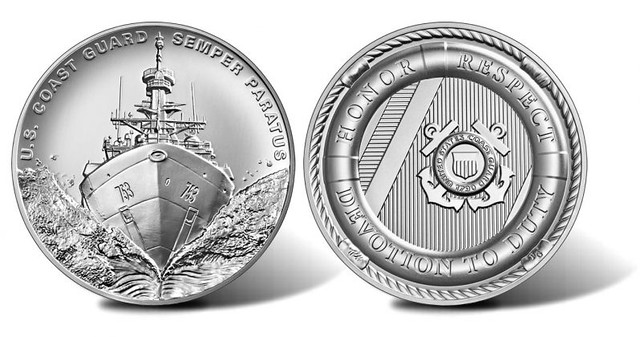
The United States Mint this week unveiled design information and images for its 99.9% fine U.S. Coast Guard 2.5 Ounce Silver Medal which will feature a diameter of 2 inches.
Scheduled to launch Aug. 16, the product is the second of five from the U.S. Mint’s Armed Forces Silver Medal Program. The first medal honors the Air Force. It will be available July 13. Forthcoming medals will celebrate the Navy, Marine Corps and Army. The Mint will also later issue bronze versions as well as smaller 1-ounce silver editions.
Medal Designs
The selected obverse (heads side) and reverse (tails side) designs were recommended by the CCAC and CFA after reviewing 18 candidate designs.
Created by Richard Masters and sculpted by Michael Gaudioso, the medal’s obverse design depicts a Coast Guard national security cutter at full throttle, speeding head-on toward the viewer.
Inscribed around the upper border are "U.S. COAST GUARD" and the Coast Guard motto "SEMPER PARATUS" (always ready). The hull number identifies the cutter Hamilton, named for Alexander Hamilton.
Created by Thomas Hipschen and sculpted by Renata Gordon, the medal’s reverse design depicts two iconic symbols of the Coast Guard — a life preserver ring and the racing stripe mark, which is found on almost all Coast Guard craft.
To read the complete article, see:
U.S. Coast Guard 2.5 Ounce Silver Medal Design and Images Unveiled
(https://www.coinnews.net/2021/07/02/u-s-coast-guard-2-5-ounce-silver-medal-design-and-images-unveiled/)
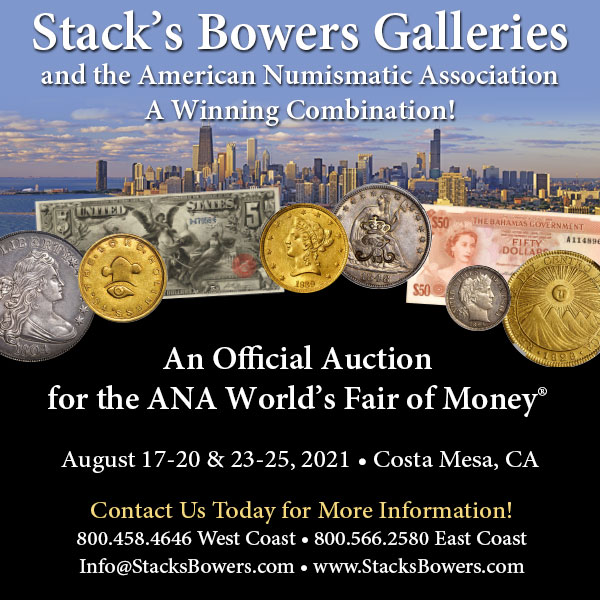
THE LIBERTY DOLLAR IS BACK
This press release published Thursday announces the return of the Liberty Dollar. -Editor
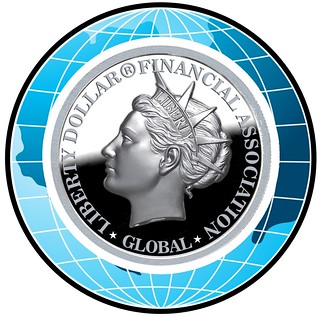 Are you concerned about the US government's announcement that it has suspended minting of some silver coins because of the silver shortage? This news was devastating for many who consider silver to be a safe hedge against inflation, but a new startup is ready to ease the shock.
Are you concerned about the US government's announcement that it has suspended minting of some silver coins because of the silver shortage? This news was devastating for many who consider silver to be a safe hedge against inflation, but a new startup is ready to ease the shock.
Liberty Dollar Financial Association (LDFA) offers its members the ability to purchase a small portion of large-block stored silver that is normally unavailable to most people. Members can monitor their accounts online and convert their silver back to US dollars at the current silver price at any time, usually within minutes, 24 hours a day. A debit card is also in the works that will provide members access to their money instantly worldwide, and Merchants can use LDFA for payment processing anywhere online or with our upcoming smartphone app for Point-Of-Sale transactions.
The LDFA physical silver is stored in an insured, independent and high security warehouse. Members' silver ownership is represented in "Liberty Dollars," a negotiable digital warehouse receipt that can be transferred electronically to any member, or to any business anywhere. This makes Liberty Dollar e-money just as valid and even more secure than Bitcoin. Now anybody can protect, profit and use their money while maintaining its purchasing power with the silver-based Liberty Dollar.
Bernard von NotHaus, the monetary architect of the original Liberty Dollar says, "With all the government spending since the election, the worst possible inflation is headed our way and the value of the US dollar is going to drop drastically. The Liberty Dollar Financial Association offers people around the world a way to maintain the purchasing power of their money and spend it everywhere US dollars are accepted."
LDFA Members can also redeem their silver in one-ounce Silver Cards, paper Silver Certificates that are themselves negotiable warehouse receipts, and custom-minted Silver Rounds for an additional minting fee.
LDFA is a Private Membership Association that costs nothing to join and provides a referral program that allows members to earn additional silver. It is also partnered with the Liberty Network, a combination Social Network and E-commerce center that allows everyone to showcase their business, skills, crafts or products to the world, offering more ways to earn.
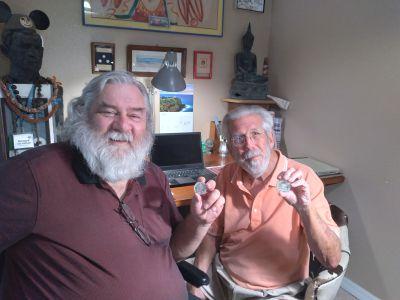
CEO Wayne Hicks and Chairman Bernard von NotHaus
To read the complete article, see:
The Silver-Backed Liberty Dollar Is Back
(https://finance.yahoo.com/news/silver-backed-liberty-dollar-back-204100338.html)
For more information, see:
https://ldfa.nl/
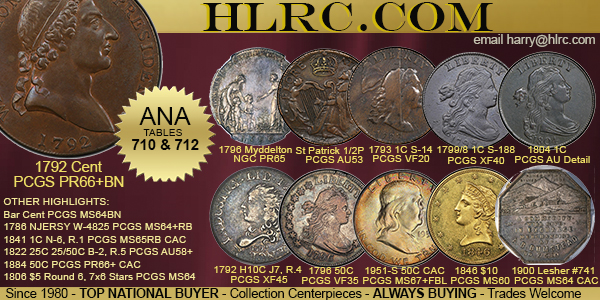
THE MYSTERIOUS NEWPORT TOWER
The New England Numismatic Association's official publication is NENA News. John Ferreri offered to share some articles with E-Sylum readers. Here's a token article that caught my eye - it's from the March 2021 issue by John himself, on the mysterious tower seen on Rhode Island paper money. Thanks! -Editor
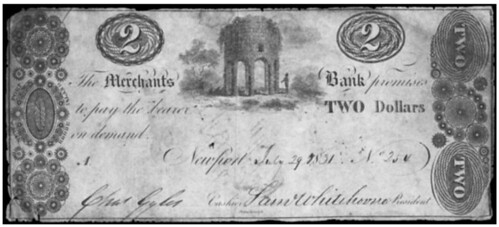
This 1831 $2 note of the Merchant’s Bank of Newport shows the mysterious tower in Truro Park in the city of Newport, RI. This was built on hilly land at one time owned by Benedict Arnold, the great-grandfather of the Benedict of Revolutionary War fame and disgrace. Notice the amount of intrusive brush that flows over the stone sides, indicating that even in 1831, the date of the engraving, this structure must have been quite old. The fact that it still stands is a testament to the workmanship involved when it originally was built. The note was engraved by Peter Maverick an outstanding banknote engraver of his day and will show the uncluttered and precise qualities of his work.
Collecting Obsolete Banknotes can sometimes turn into an archeological event as with the image of the Newport Tower
as shown on an 1831 issue of the Merchants Bank in Newport, Rhode Island . The banknote image available to this author
comes from an online source and while of mediocre quality is still
sharp enough to discern some of the finer points of the tower.
So, what is the tower? Good question! In the past it has been called by various names and attributed to various peoples.
It is a sturdy structure made of uncut stone and mortar not unlike the stone which may be found in the immediate area of Newport. Today it rests in a small park surrounded by Pelham, Truro W. and Mill Streets and Bellevue Ave. It is round, has eight legs and arches and seems to be missing a floor or two inside. There are niches made in the inner wall that could be for floor joists or maybe for the inner workings of a mill.
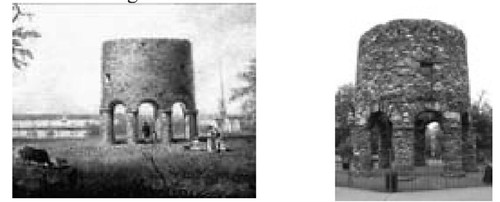
Two different pictures of the Newport Tower, one a painting and the other, a modern photograph.
It seems that no written records of its architect and construction are known. Was it a windmill built by the elder Arnold or could it be that the Vikings landed here in years past and constructed this tower with which to burn brush and signal to others off shore on ships, of their whereabouts? Or, could it have been built by some Chinese explorer who came ashore here to erect a tower, similar in appearance to those made in China during the Song Dynasty in the 1840’s? Some believe that the Knights Templar had a hand in its construction as they were master stone builders.
The most believable theory (to this author), would be that it was designed and built by Peter Harrison, a widely known master architect both in Newport and other areas of the Colonies in about 1750-1770. This time frame for the Tower has been confirmed by carbon dating of the mortar substance found in its matrix. The tower itself is 28 feet tall and while rough in appearance, is actually sturdy enough to have withstood almost 300 years of New England hurricanes, tornadoes, ice events and bomb cyclones that seem currently to be in vogue! It has witnessed the church marriage of at least one President (John Kennedy) and is a neighbor to various late 1800’s industrialists’ mansions built high above Easton Bay on the east shore of the town.
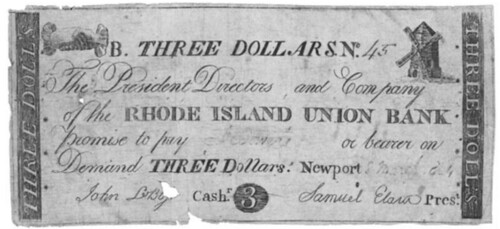
This counterfeit note dated 1804 and issued by the Rhode Island Union Bank shows very poor workmanship, especially with the lettering. However this note may show the one clue that proves the original purpose of the Newport Tower!
Credit for this image goes to Stack’s Bowers Galleries. The image was previously shown in banknote form in Volume 5 of the Whitman Encyclopedia of Obsolete Paper Money.
So, what did he build? The vignette on this other Newport banknote of the Rhode Island Union Bank printed in 1804 certainly shows a structure that is unmistakably, a windmill. The note is probably a counterfeit (there are no known genuine $3 bills like this) but wouldn’t a counterfeit note have an almost exact resemblance to the genuine? And, with the abundance of wind coming off the sea, a hill in Newport would be a natural place to build a windmill!
The next time you visit little old Newport you might want to stop at the Tower to see what exactly you think of it! If current banknotes used in Newport could display scenery of local areas what do you think would be shown on them, the Cliff Walk, Castle Hill Lighthouse and the Tennis Hall of Fame? This is what makes collecting U.S. Obsolete Paper Money so interesting. One never knows what scenery will be found on these bills. Sometimes it is up to the reader to identify it!
Historic structures, wartime battles, identifiable street scenes, famous ships and historic moments are captured in the artists vignettes used on many of New England’s mid 1800’s paper money issues. This note is a good example!
To learn more about collecting paper money or to inquire about membership in the Currency Club of New England contact Kevin Lafond, P.O.Box 4724, Porstmouth, NH 03802-4724 or kglafond@comcast.net, phone (603) 498-2042.
For more information on the New England Numismatic Association, see:
https://www.nenacoin.org/

THE ART OF STACKING COINS
We've discussed this topic in the past - coin stacking. Len Augsburger forwarded an article with some great photos of creative coin stacks. -Editor
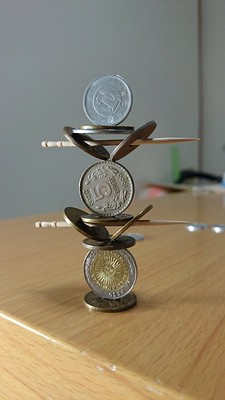 Japanese Twitter user @thumb_tani (aka Tanu) has mastered the art of balance. He uses his keen sense of equilibrium to create small, fascinating sculptures from carefully-positioned coins. Although many of us have probably attempted this same sort of coin stacking, Tanu takes these arrangements to a whole new—and totally epic—level.
Japanese Twitter user @thumb_tani (aka Tanu) has mastered the art of balance. He uses his keen sense of equilibrium to create small, fascinating sculptures from carefully-positioned coins. Although many of us have probably attempted this same sort of coin stacking, Tanu takes these arrangements to a whole new—and totally epic—level.
Using a variety of denominations, Tanu creates intricate structures that range in shape and size. Often, he'll first build a strong base using staggered coins. Then, he does the seemingly impossible. Tanu stands the coins upright and places them edge-to-edge without the discs falling or even wobbling. From there, he’ll sometimes stack even more coins (or other objects) on top. It’s a mesmerizing sight, but also one that you’ll want to hold your breath for. The precarious sculptures look as though they could tumble at any moment.
To read the complete article, see:
Japanese Man Masters the Gravity-Defying Art of Stacking Coins
(https://mymodernmet.com/thumb-tani-tanu-japanese-coin-stacking/)
To read the earlier E-Sylum article, see:
AMAZING COIN STACKING VIDEOS
(https://www.coinbooks.org/esylum_v19n50a36.html)
MORE AMAZING COIN STACKS
(https://www.coinbooks.org/esylum_v19n51a35.html)
